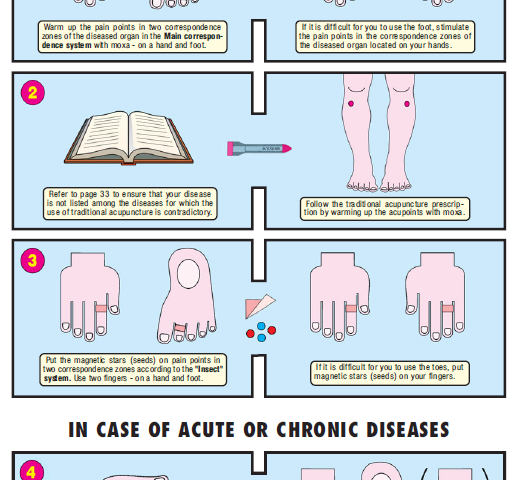Sujok Healing Prescription

Acceptance of Pain and Disease
July 16, 2016
Pranic Healing
July 17, 2016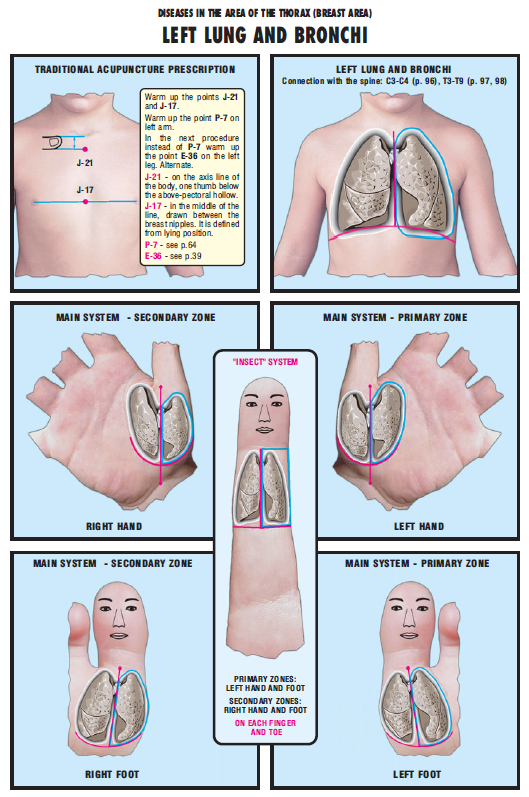
Sujok Prescription for Left Lung and Bronchi 20

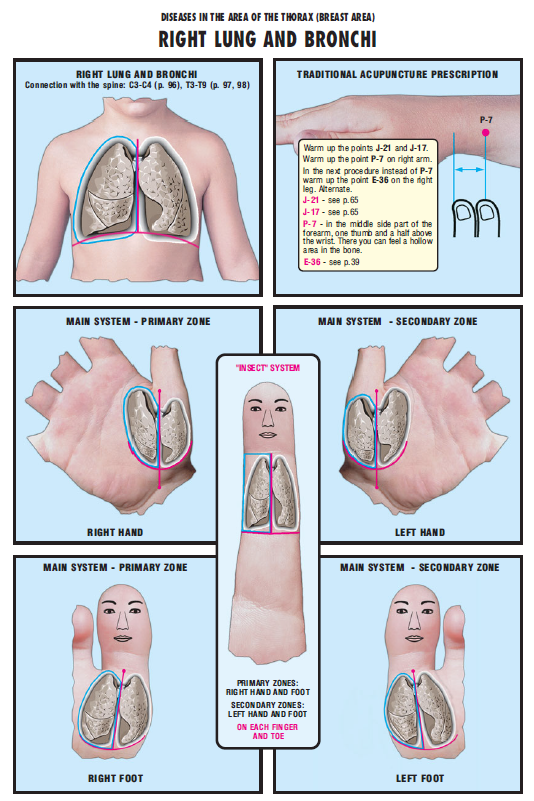
Sujok Prescription for Right Lung and Bronchi 19

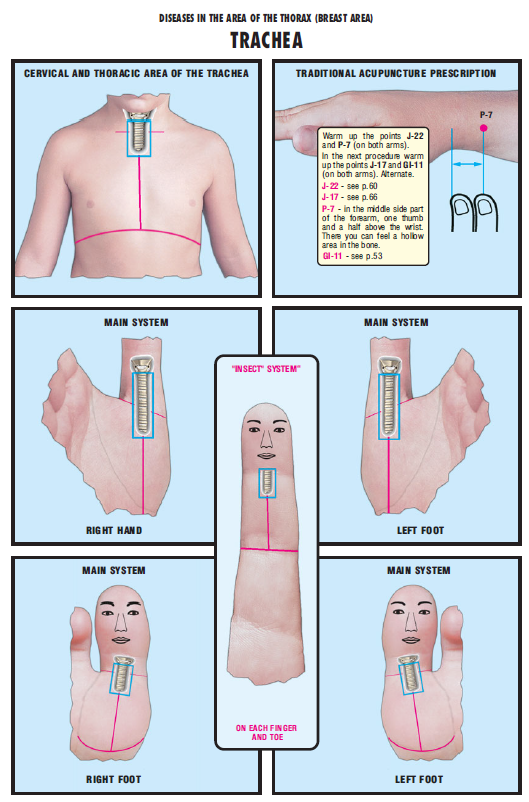
Trachea Sujok Prescription 18

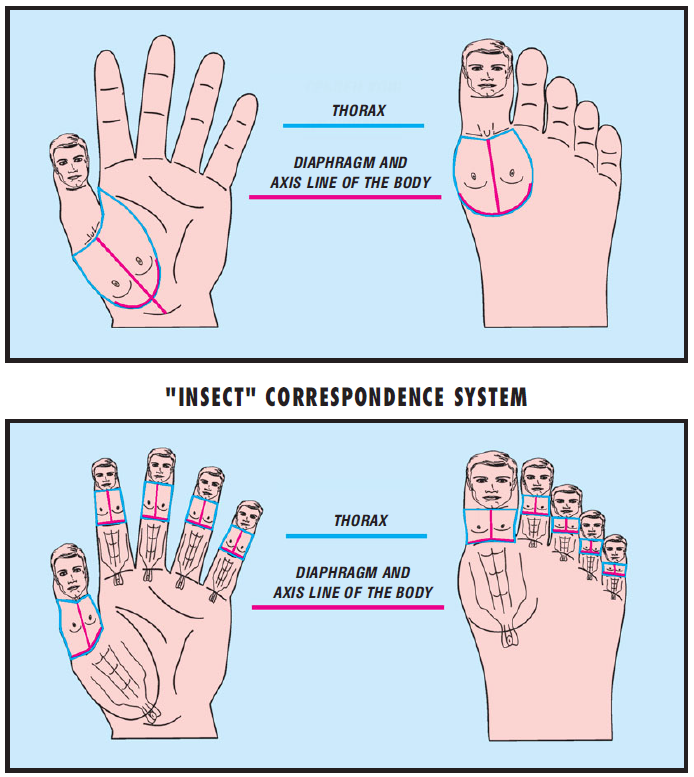
Thorax Sujok Prescription 17
DISEASES IN THE AREA OF THE THORAX
CORRESPONDENCE ZONES OF THE THORAX
MAIN CORRESPONDENCE SYSTEM
In the Main system the thorax is outlined on the hands from the “life line”, and the axis line, dividing the thorax in two halves, is projected from the middle of the thumb’s base to the middle of the skin flap in the base of the wrist.
The diaphragm, separating the thorax from abdominal area, is symmetrically projected on the life line from the both sides of the axis line.
On the feet, the thorax is outlined on the ball, which forms when the thumb is bent to the foot. The diaphragm is projected on the flap, outlining this ball.
In the “Insect system” the thorax is projected on the middle phalanx of the toes.

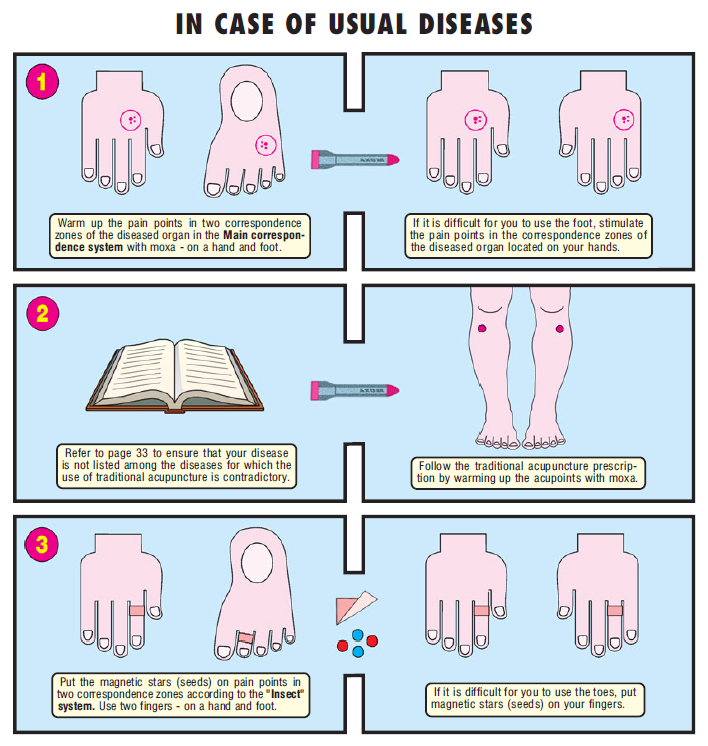
IN CASE OF USUAL DISEASES 1
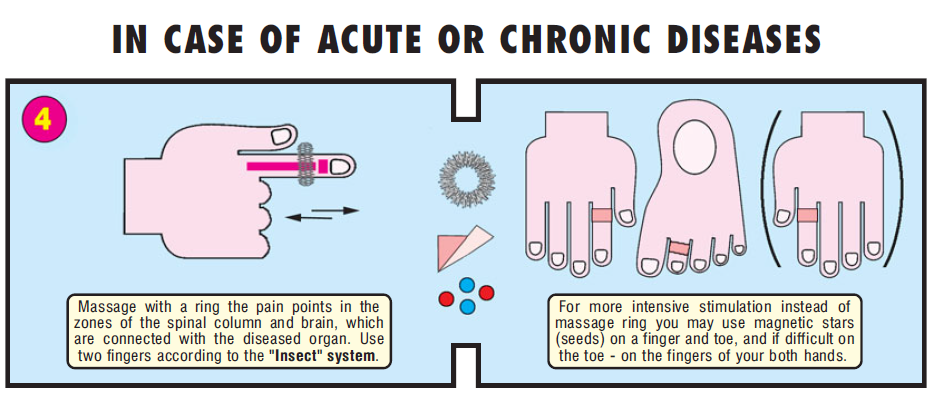
IN CASE OF ACUTE OR CHRONIC DISEASES 2
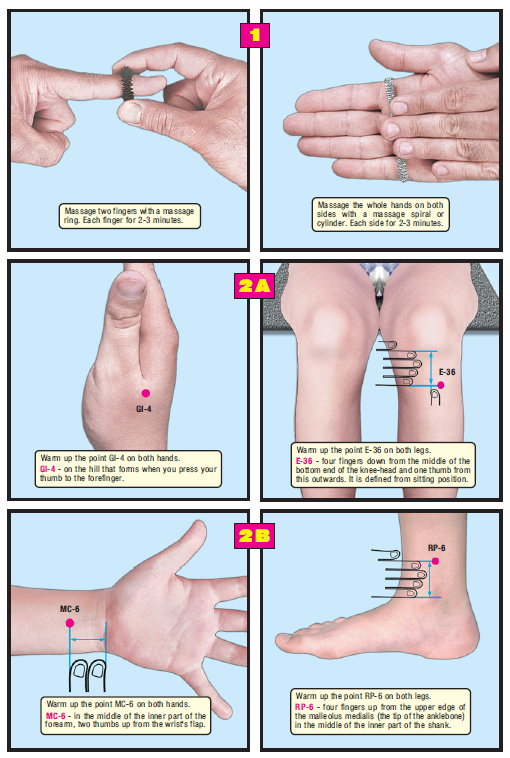
PRESCRIPTIONS KEEPING FIT, GENERAL STRENGTHENING 3

We will pay special attention to this prescription, because of its prophylactic nature. If used on regular basis it might ensure a good health for up to old ages and can also save you the necessity to use the other prescriptions in this guide.
The contents of the procedure here is more different from the standard procedure. For that reason we describe it separately.
The prescription combines the use of su jok and traditional acupoints. Except for keeping fit, it can be also used:
- To make the immune system stronger in cases of various conditions which require such a thing – viral diseases (influenza, hepatitis etc.), preparation for surgical operations, after operation recovery etc.
- For treatment of light, banal illnesses, regardless of their nature.
- As an addition to main treatment with medicines, herbs etc. of more severe diseases involving a general organism disorder, when there is no clearly expressed focus of the disease or there are large areas which are affected. Its application shortens the treatment process and vastly decreases the amount of medicines taken.
The prescription is performed:
- For keeping fit – monthly in 4 to 6 consecutive days.
- For reinforcement of the immune system – a course of ten daily procedures.
- For treatment of light, banal illnesses – daily, to the full disappearing of the symptoms, plus two or three procedures more, to stabilize the result.
- If used as an addition to main treatment with medicines, herbs etc. – daily, to the end of the main treatment.
The prescription consists of two parts. The first – massage of the correspondence systems with various massagers. The second – two ancient Chinese combinations of traditional points for general reinforcement of the organism, which are alternated – in one procedure – one of the combinations, and in the next – the other. The two parts of the prescription can be performed in combination or separately.
- Massage for one minute two of the fingers with a massage ring and the whole hands with a massage spiral or cylinder.
The intensive hands’ massage activates all pain su jok points that have appeared there and has a strengthening effect on the whole organism. If a regular massage is practised, all pain points are stimulated even by their appearance, in the beginning of the disease’s development. Then a not so intensive impulse is also enough for you to overcome the disease, to stop it in its initial stage.
- 2. Warm up with moxa for 10-12 each of the traditional acupoints, as follows:
3. He Gu (GI-4) and Zu San Li (E-36) on both hands and legs. - By next procedure Nei Guan (MC-6) and San Yin Jiao (RP-6) on both arms and legs.
Continue the procedures, alternating combinations A and B.
The Zu San Li, He Gu, Nei Guan and San Yin Jiao points are considered one of the most important in the traditional acupuncture. They have a powerful strengthening and healing effect. Their periodical warming up with moxa regulates the deviations in the energy system of the organism, before they have intensified, and keeps you in a good health.
Here are some of the most distinguishing features of these points in detail, which can show you their wide spectrum of application
Zu San Li (E-36):a general strengthening point, with proved effect against brain insults, heart diseases, a main point for regulating the blood pressure (by severe forms of hypertension in some eastern countries cauterization of Zu San Li, till a blister appears, is still used today), all gastric and intestinal diseases, aches in legs and waist, diseases of the eyes, nervous system, urino-genital system, asthenia, allergic conditions, diseases of the respiratory organs, general weakness, it increases the energy in all meridians and regulates the deviations in the energy condition of the organism, it is effective by aches in the lower half of the body.
He Gu (GI-4): a general strengthening point, diseases of the nervous system, eyes, ears, nose, throat (colds), teeth, sinuses, headache, fever, gynecological diseases, diseases of the digestive system stomach aches, constipation, it is effective by aches in the upper half of the body.
Attention: He Gu should not be used by pregnant women, because it activates the uterus and can lead to a premature birth.
Nei Guan (MC-6): a general strengthening point, main point for treatment of neuroses, maniacal conditions and regulating of mental disorders. The treatises from ancient China say that this point is stimulated, „when the sick man is full of desire to kill someone”, an important point with heart diseases, diseases of the lung, stomach, it regulates the blood pressure, effective with insomnia.
San Yin Jiao (RP-6): a general strengthening point, it is effective with diseases of the digestive system – stomach, intestines, liver and pancreas, urino-genital system – kidneys, bladder, ureters, male and female genitals, diseases of the lower limbs, it regulates the blood pressure.

Head and Neck Sujok Prescription 4
DISEASES IN THE AREA OF THE HEAD AND THE NECK
CORRESPONDENCE ZONES ON THE HEAD AND THE NECK
MAIN CORRESPONDENCE SYSTEM

In the Main system the correspondence zone of the head is located on the first phalanx of the thumb, and this of the neck – on the second phalanx.
In the “Insect” system the correspondence zone of the head is located on the first phalanges of all fingers and toes. The neck is projected in a small area between the first and the second phalanx of the fingers and toes, on the joint and a bit above and below it.
Here we have presented the lower projection of the head. For treatment you can also use the upper projection. In some cases it is even more convenient, because it doesn’t lie on soft tissues and the points are easier to be found on it. You will get an idea about the position of the head organs on the upper projection from the illustration below.
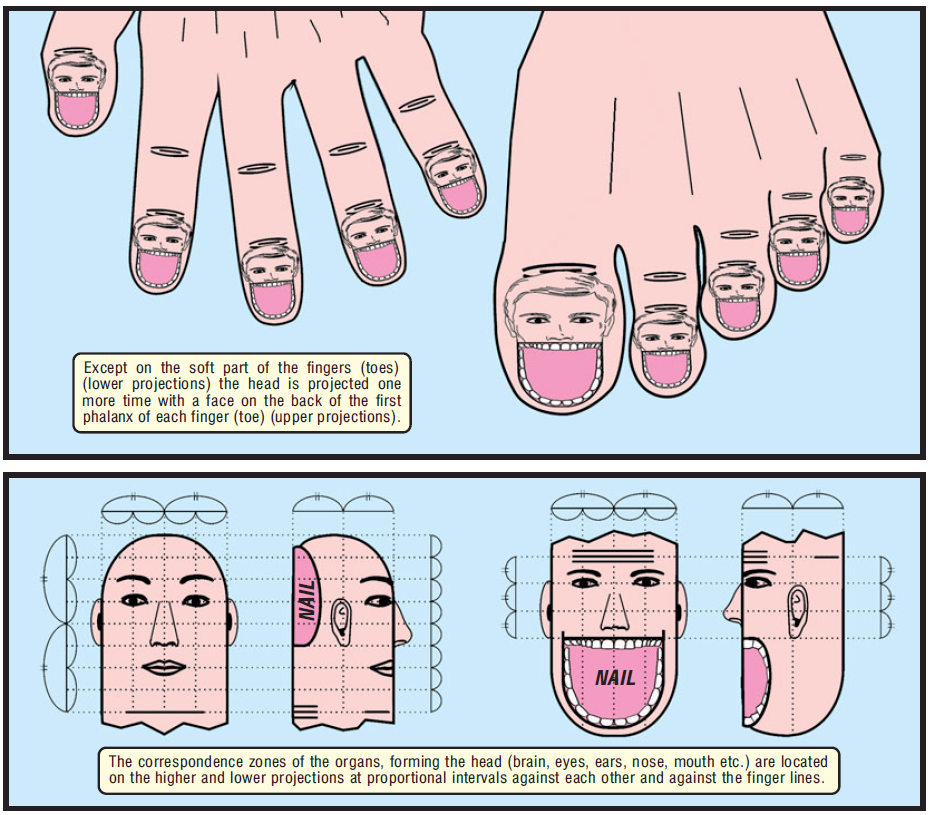
DISEASES IN THE AREA OF HEAD & NECK
HYPOPHYSIS
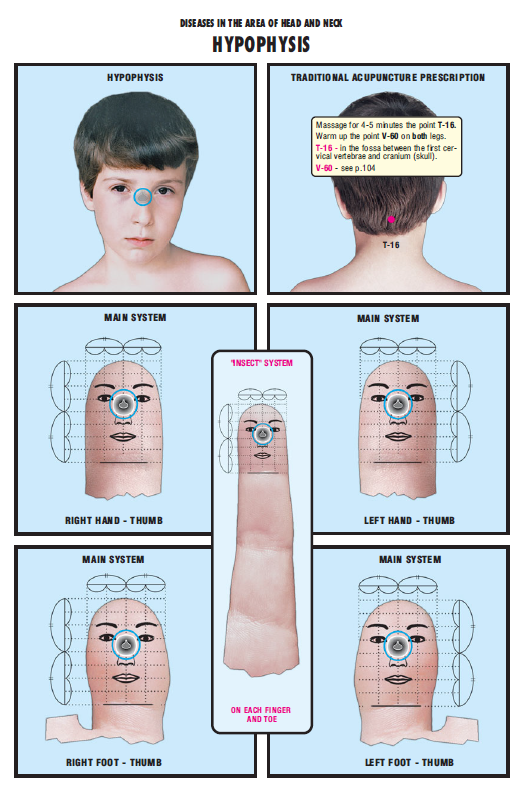
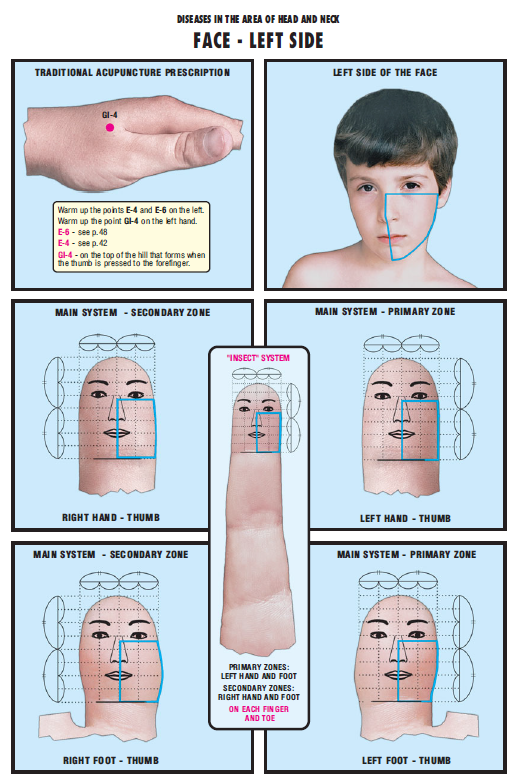
Face Sujok Prescription 5

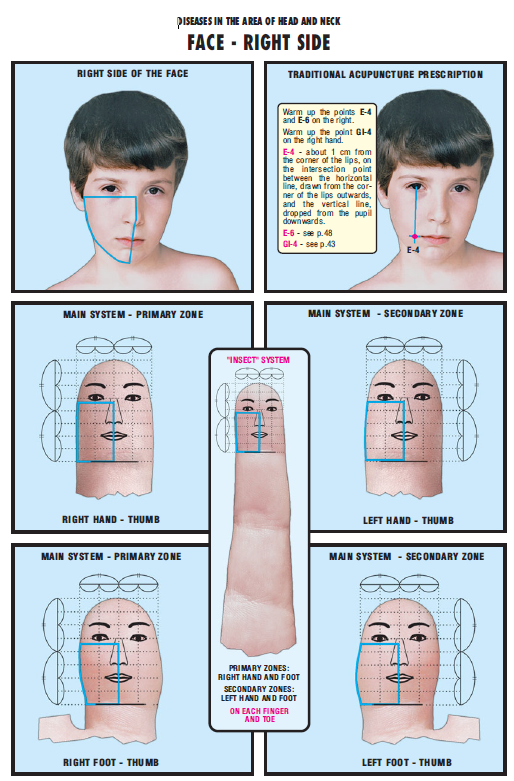
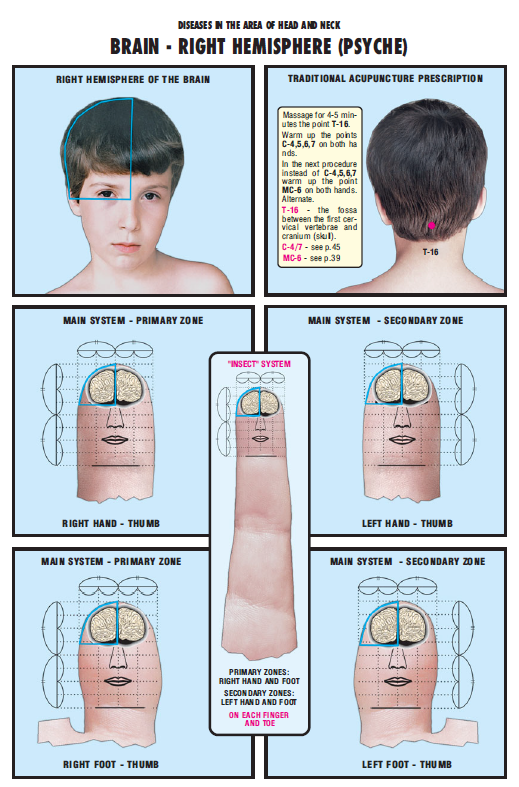
Brain Sujok Prescription 6

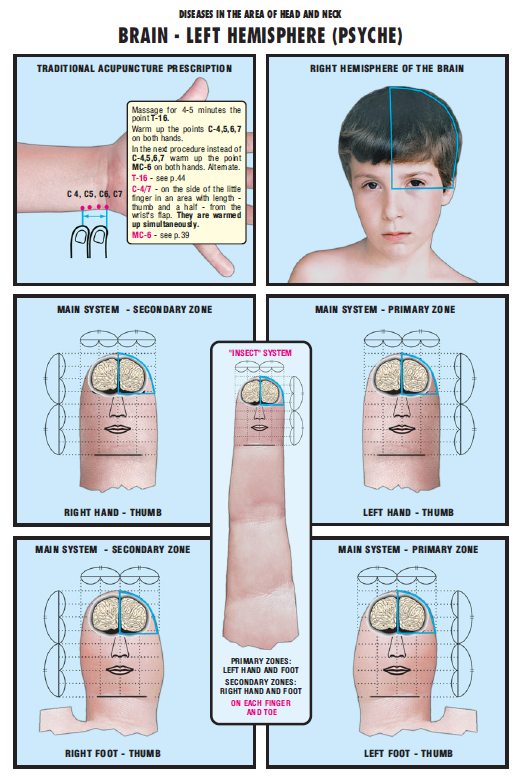
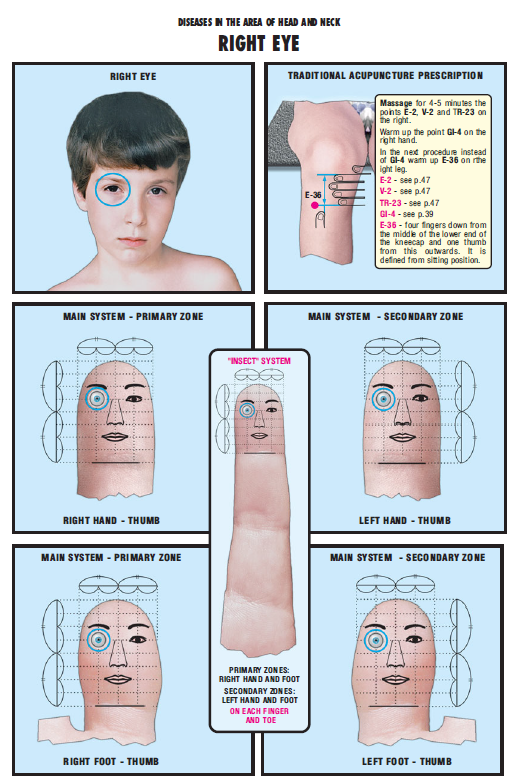
Eye Sujok Prescription 7

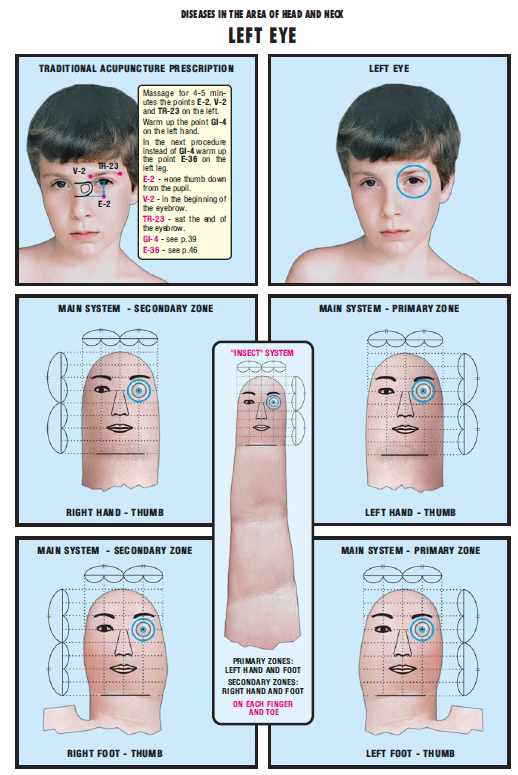
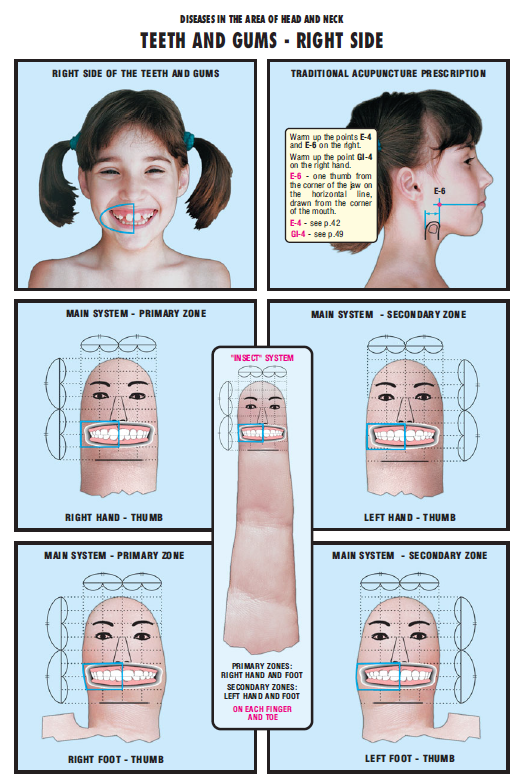
Teeth and Gums Sujok Prescription 8

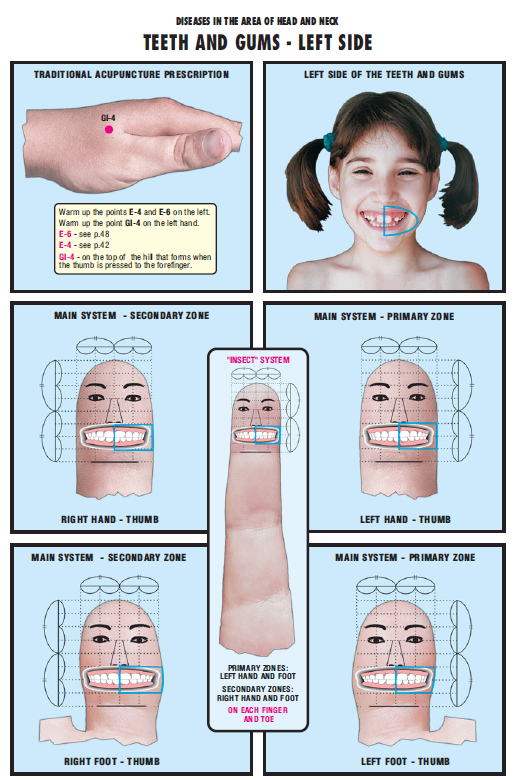
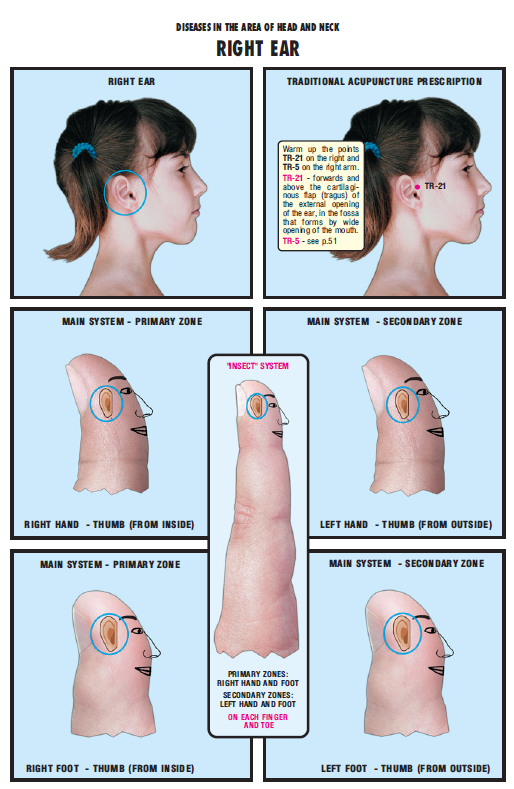
Ear Sujok Prescription 9

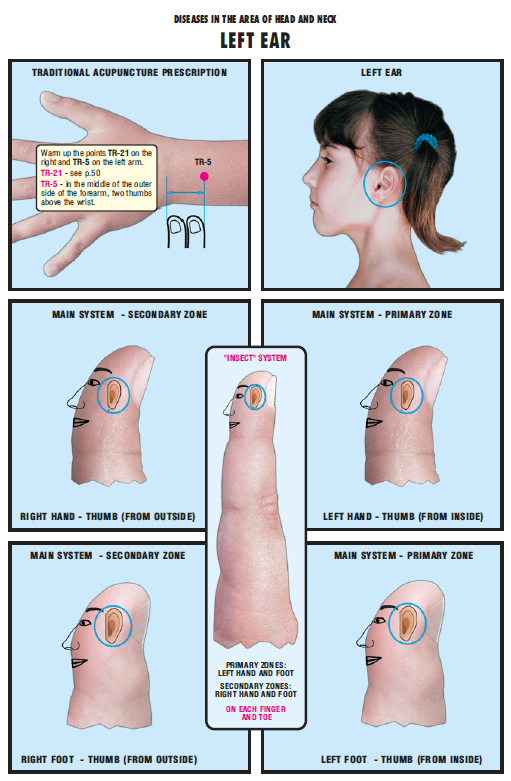
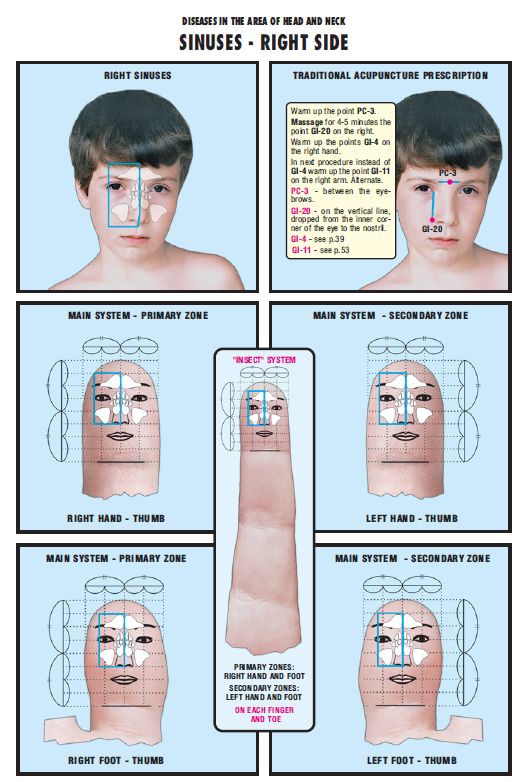
Sinuses Sujok Prescription 10

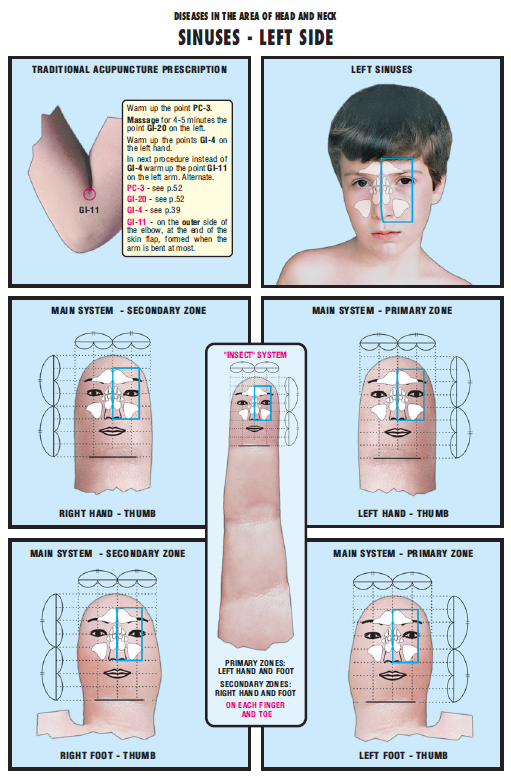
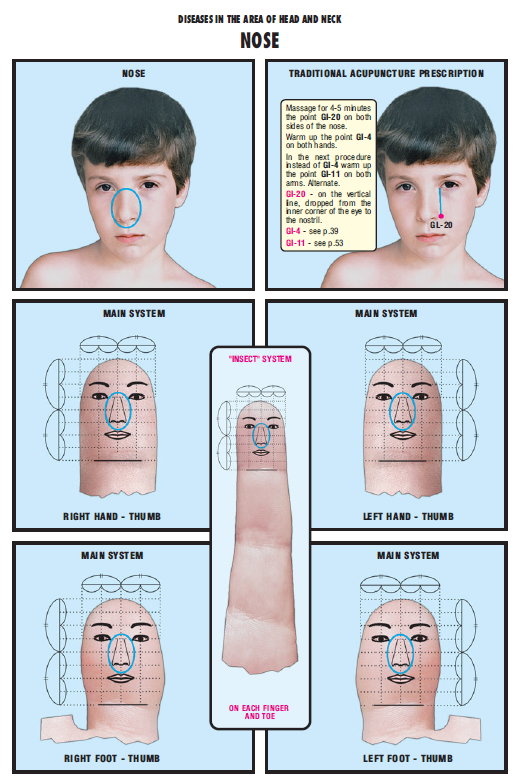
Nose Sujok Prescription 11

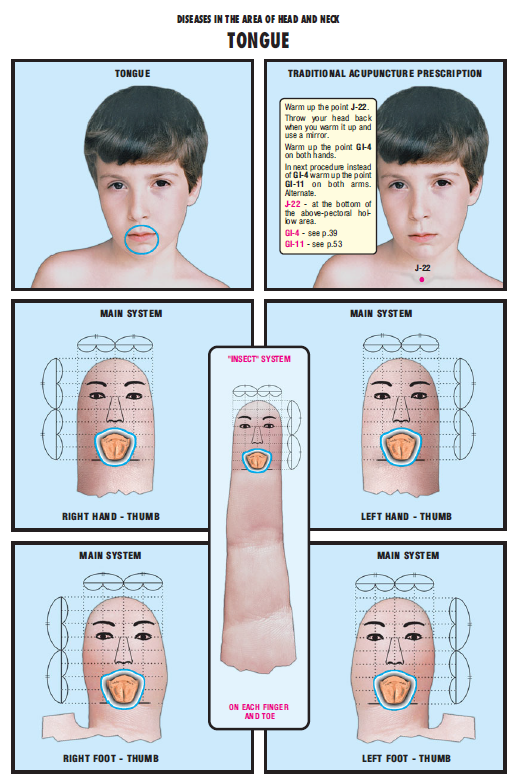
Tongue Sujok Prescription 12

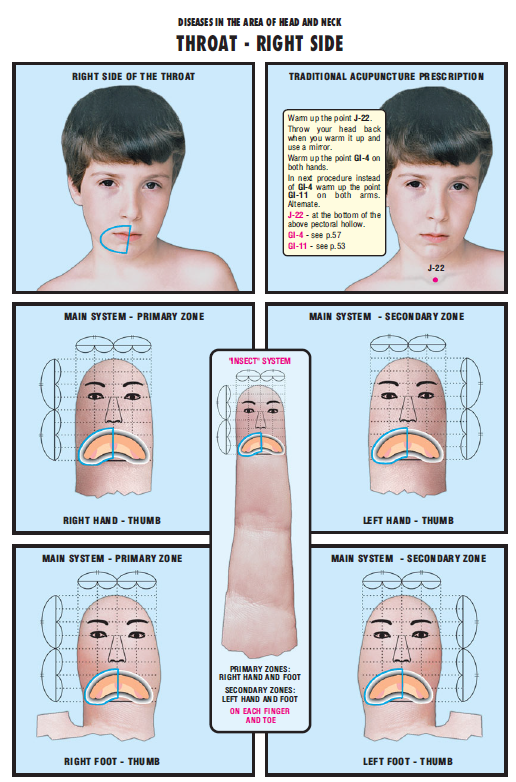
Throat Sujok Prescription 13


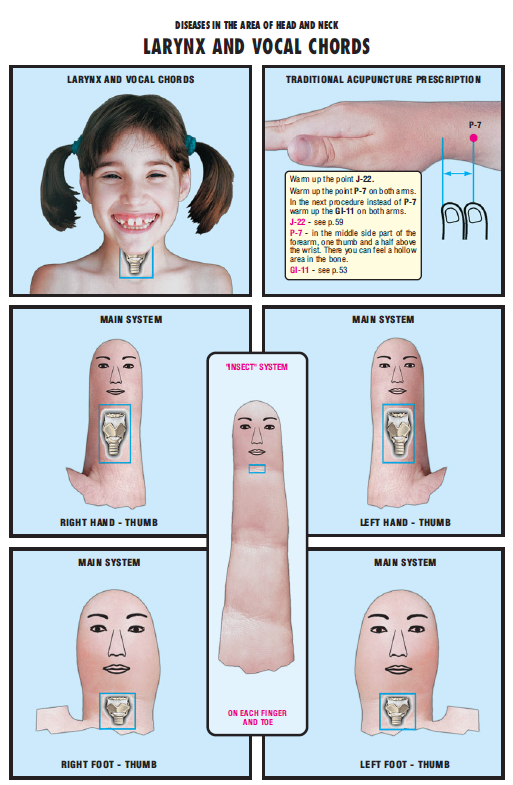
Larynx and Vocal Chords Sujok Prescription 14

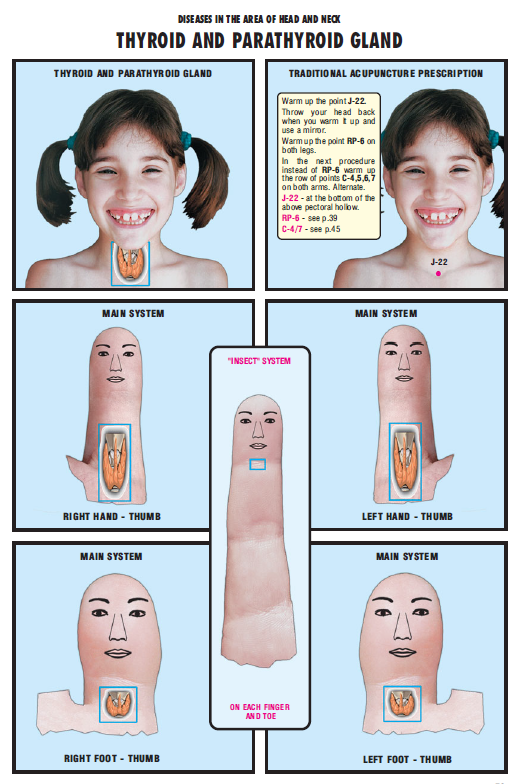
Thyroid and Parathyroid Gland Sujok Prescription 15

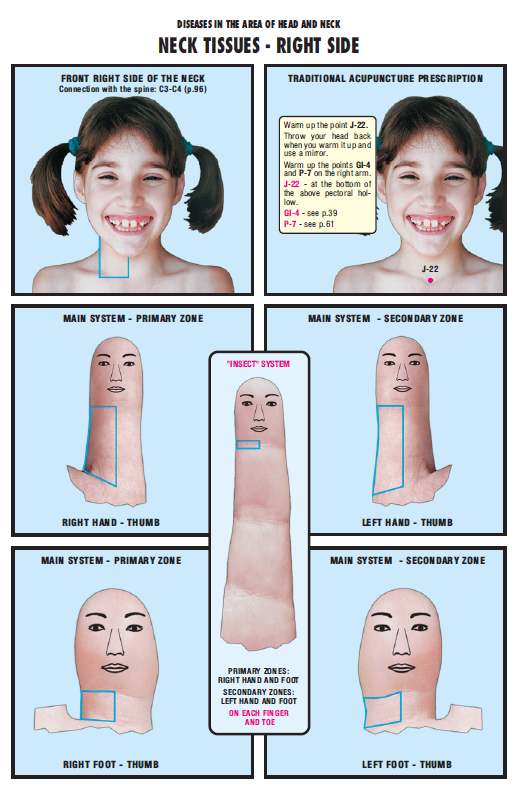
Neck Tissues Sujok Prescription 16



Sujok Prescription for Breast Tissues Right Side 21

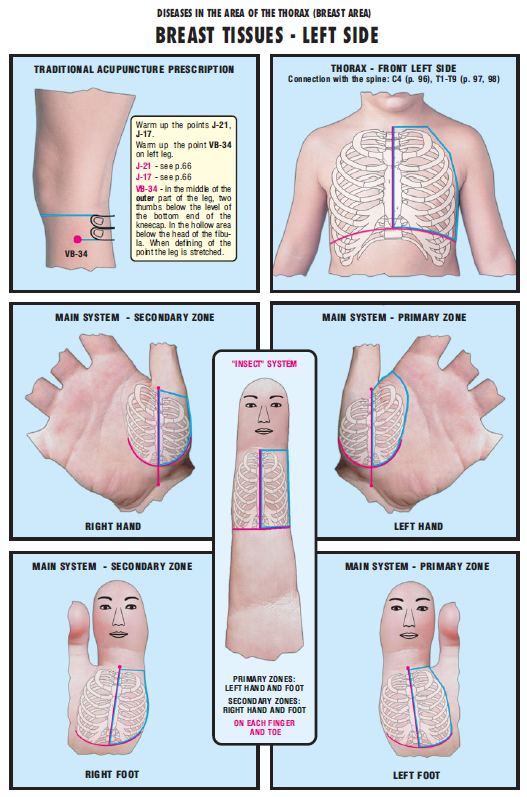
Sujok Prescription for Breast Tissues Left Side 22

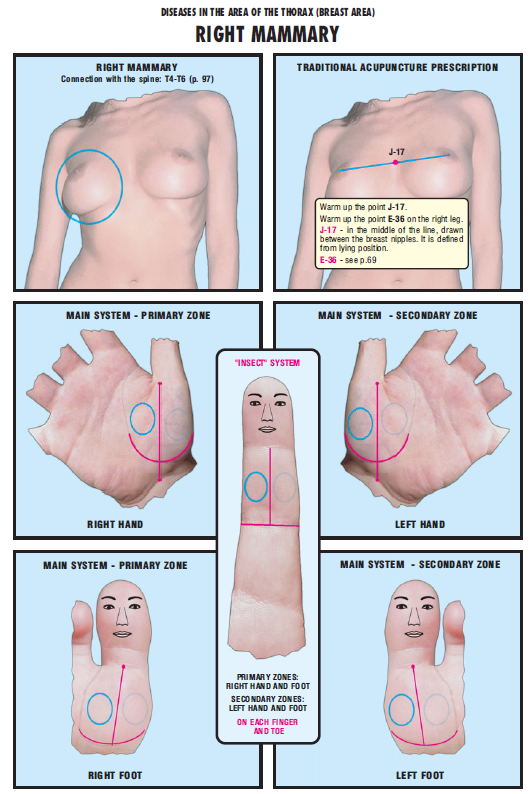
Sujok Prescription for Mammary 23
Right Mammary

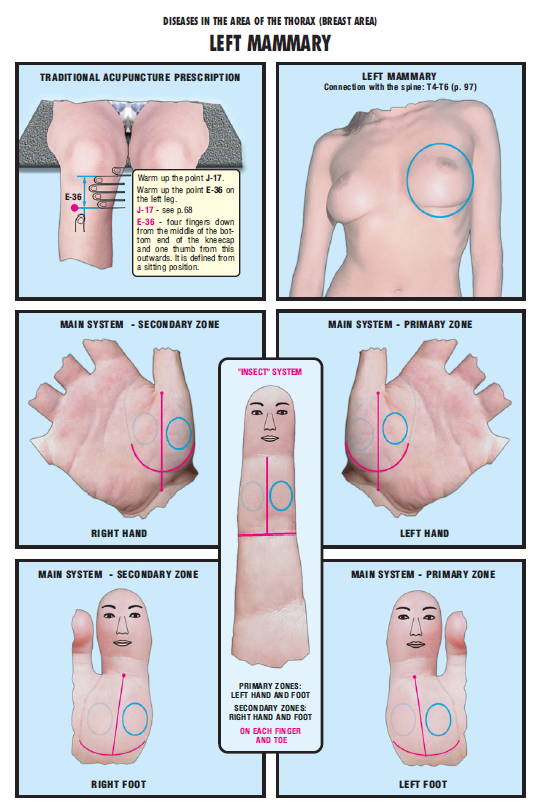
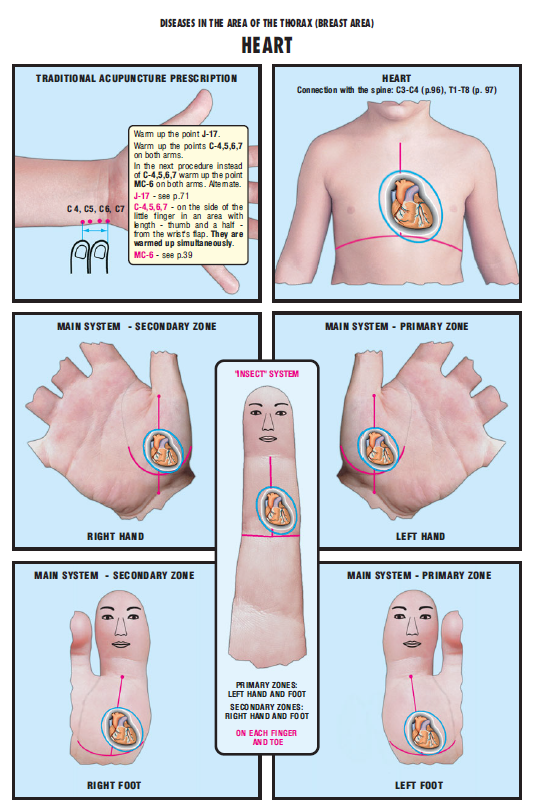
Sujok Prescription for Heart 24
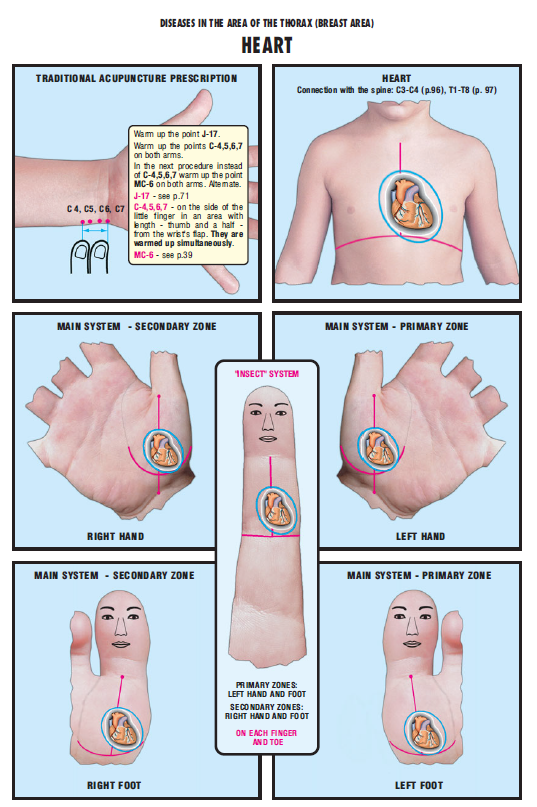
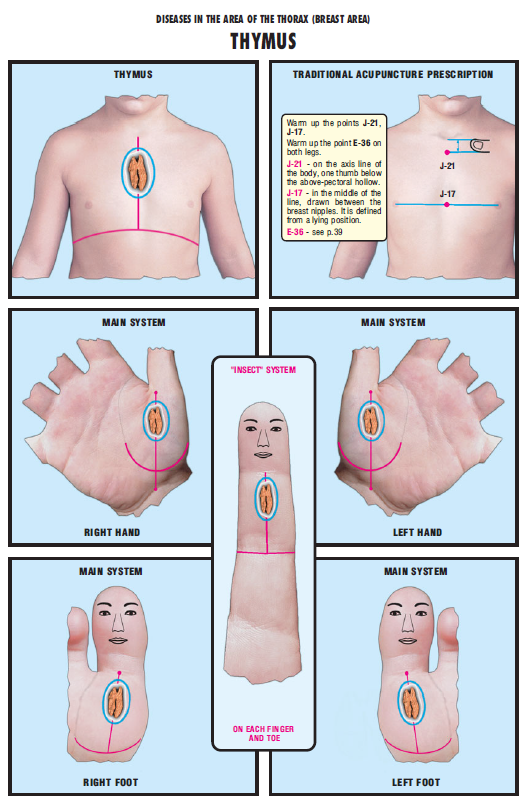
Sujok Prescription for Thymus 25

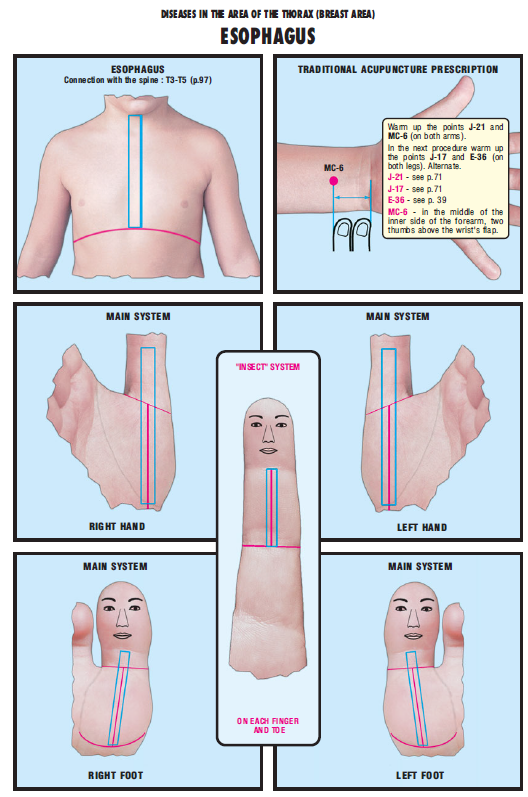
Sujok Prescription for Esophagus 26

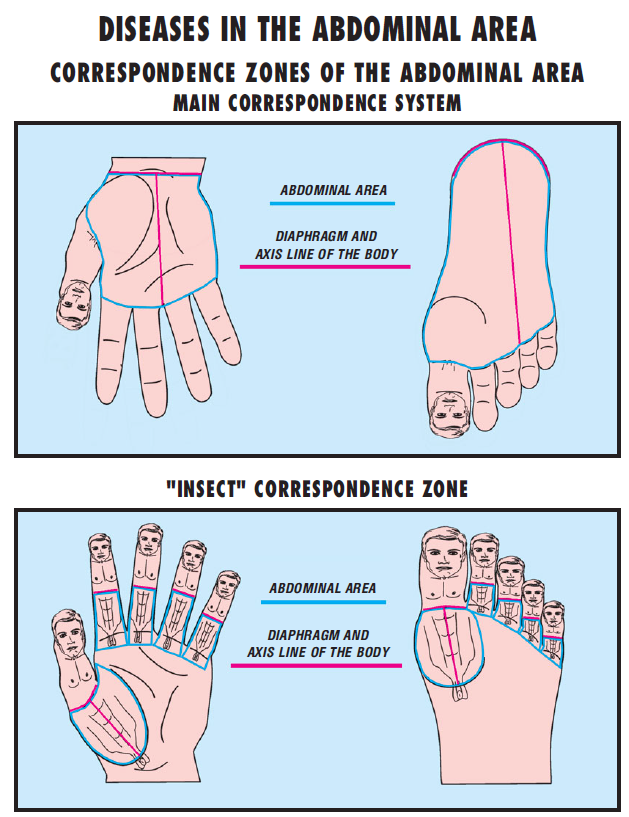
Sujok Prescription for Abdominal Area 27

In the main system the abdominal area is projected on the palm and foot. The position of the diaphragm on the palm coincides with the skin flap at the wrist’s bottom. On the foot, it coincides with the contour, outlining the back side of the heel, looked from below.
In the “Insect” system the abdominal area coincides with the inner part of the proximal (third) phalanges of all fingers and toes (without the thumbs). On the thumbs the abdominal area is projected on the first bone before the wrist and the first bone before the foot. Here the abdominal area is “stratified” and coincides exactly with the correspondence zone of the thorax according to the Main correspondence system (see below image).

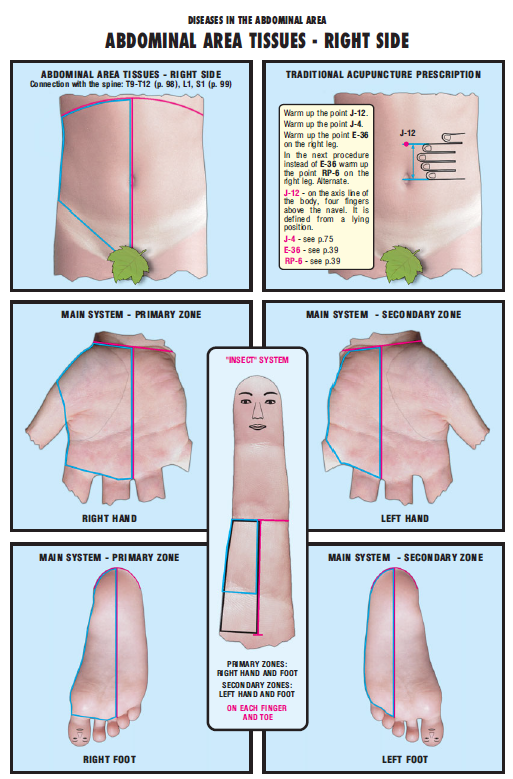
Sujok Prescription for Abdominal Area Tissues 28

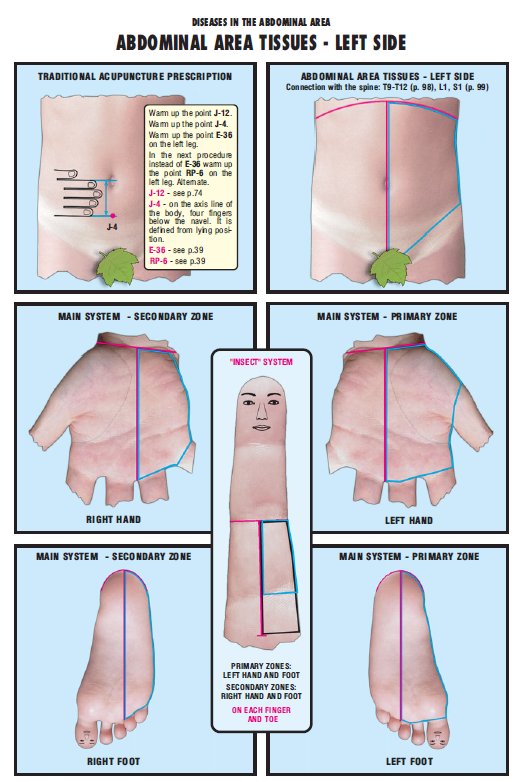
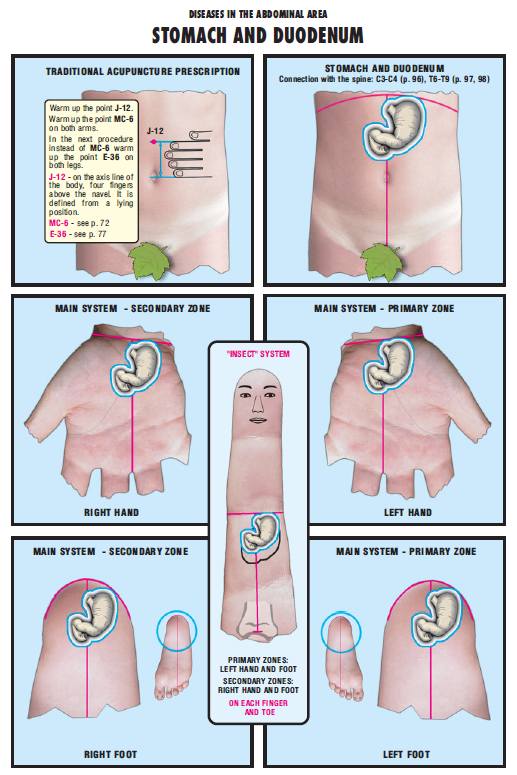
Sujok Prescription for Stomach and Duodenum 29


Sujok Prescription for Pancreas 30

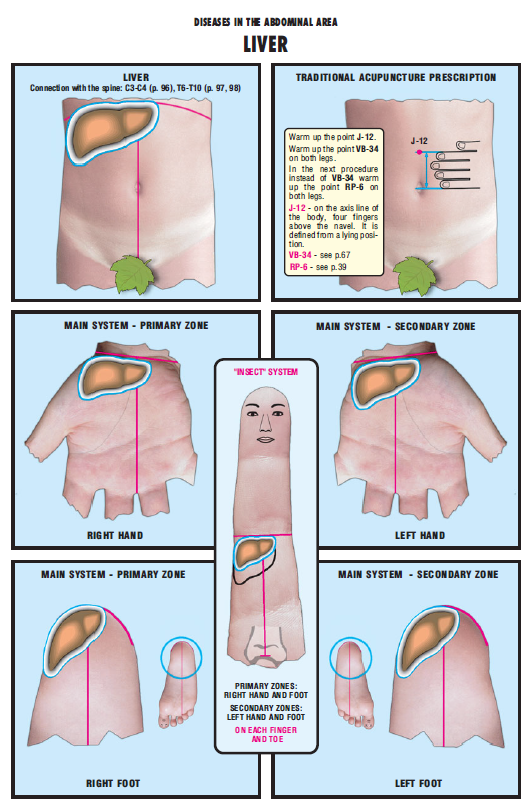
Sujok Prescription for Liver 31

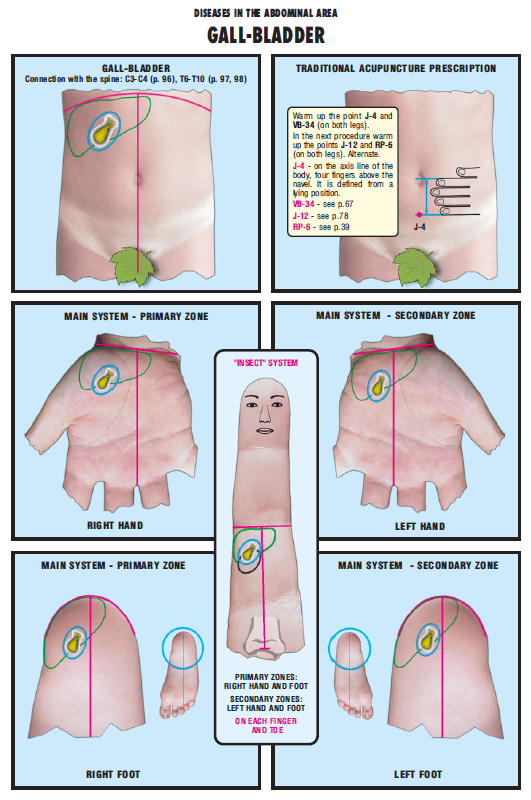
Sujok Prescription for Gall Bladder 32

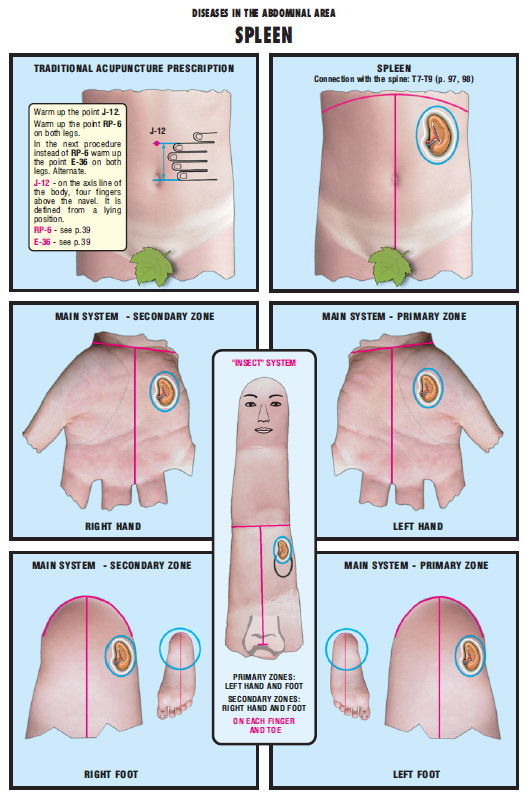
Sujok Prescription for Spleen 33

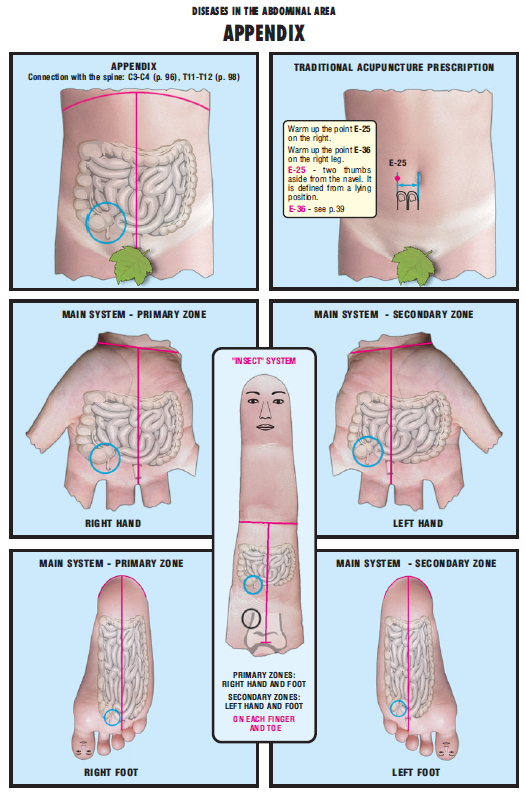
Sujok Prescription for Appendix 34

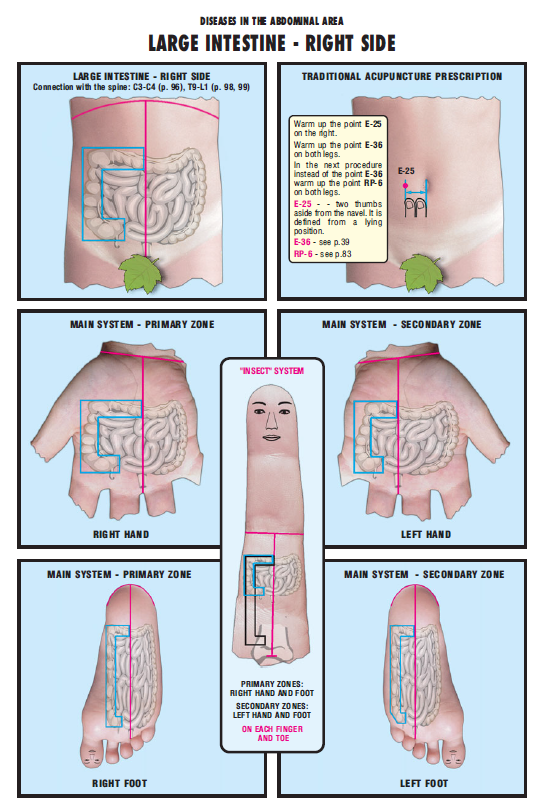
Sujok Prescription for Large Intestine 35

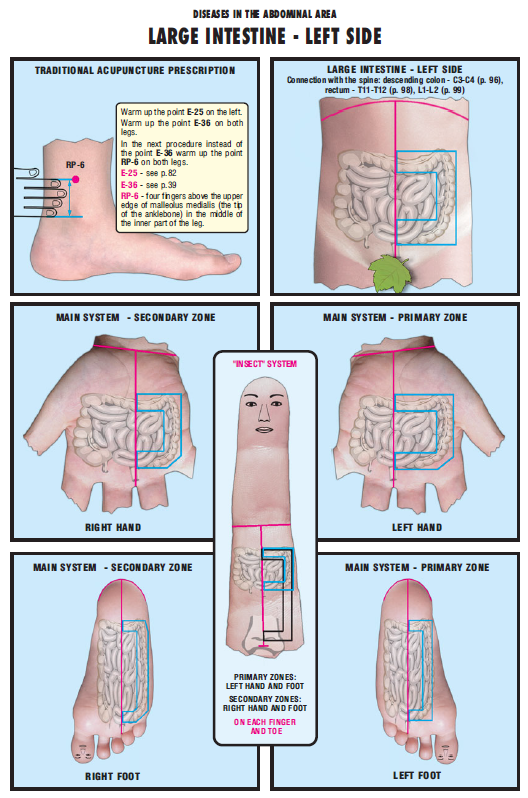
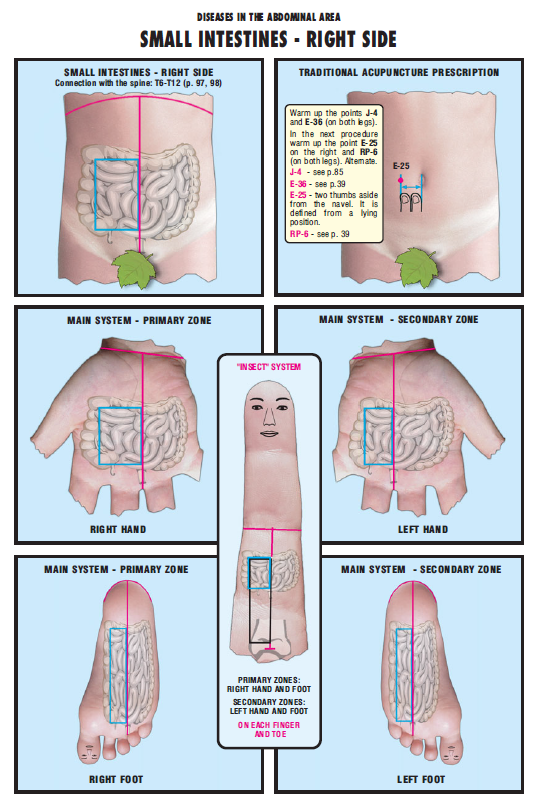
Sujok Prescription for Small Intestine 36

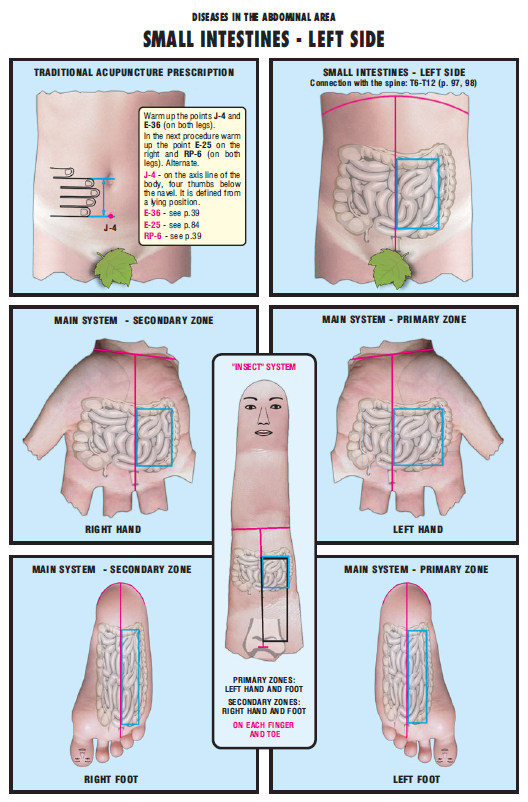
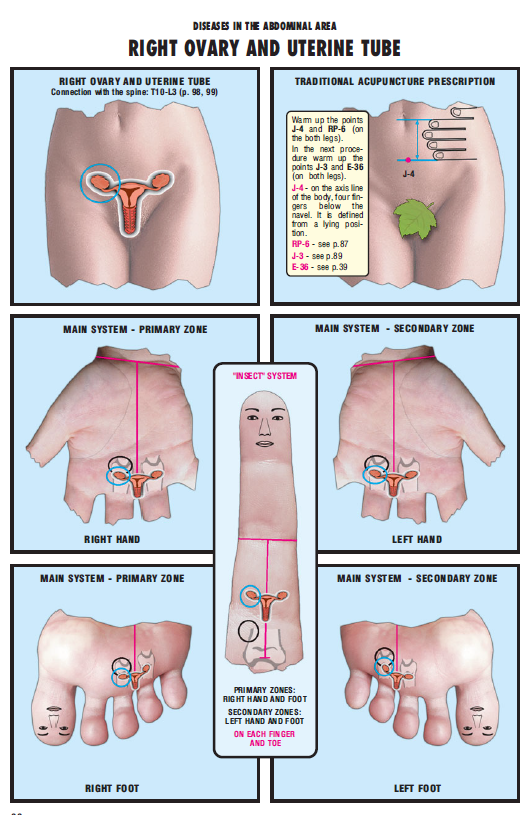
Sujok Prescription for Ovary and Uterine Tube 37


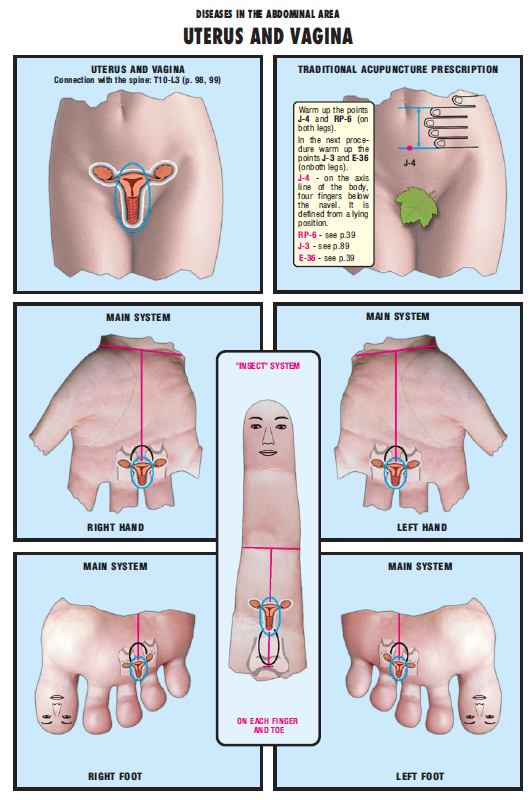
Sujok Prescription for Uterus and Vagina 38

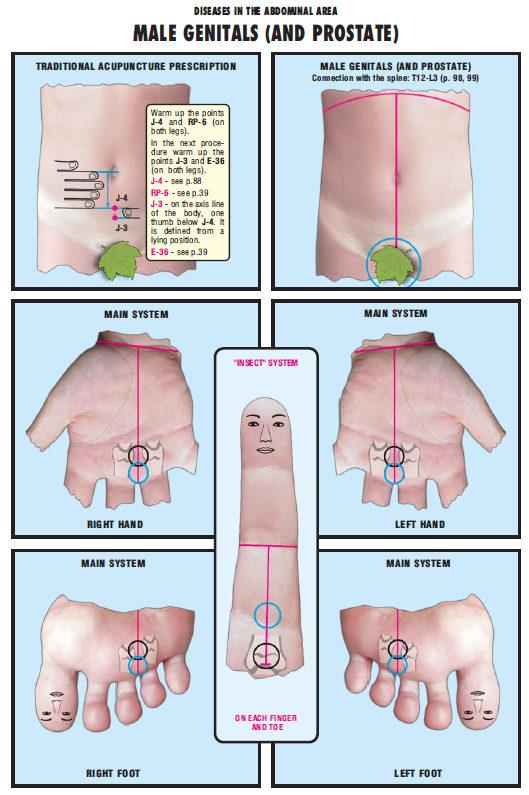
Sujok Prescription for male genitals and prostate 39

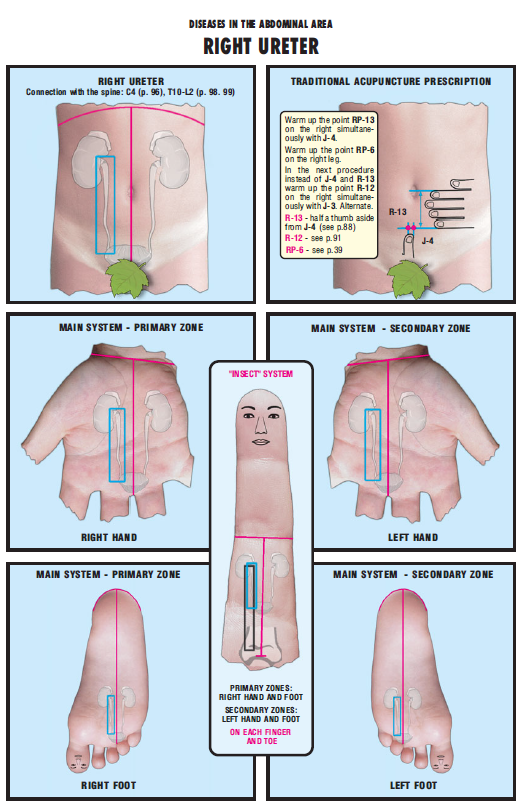
Sujok Prescription for Ureter 40

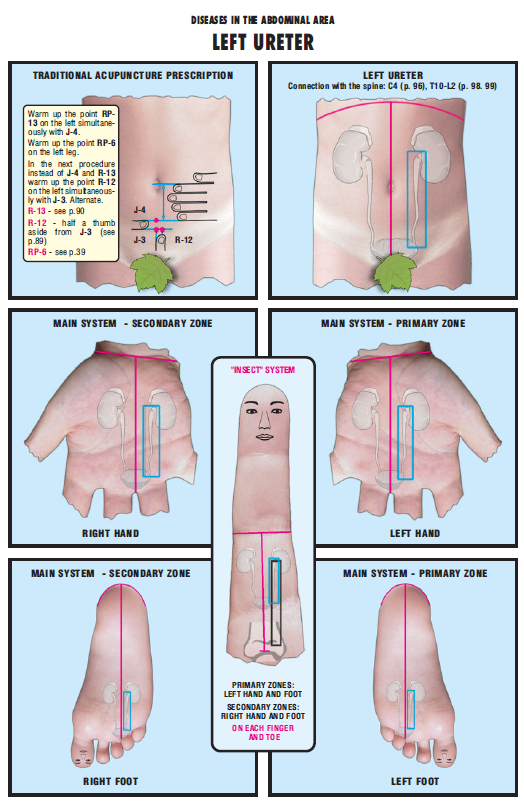
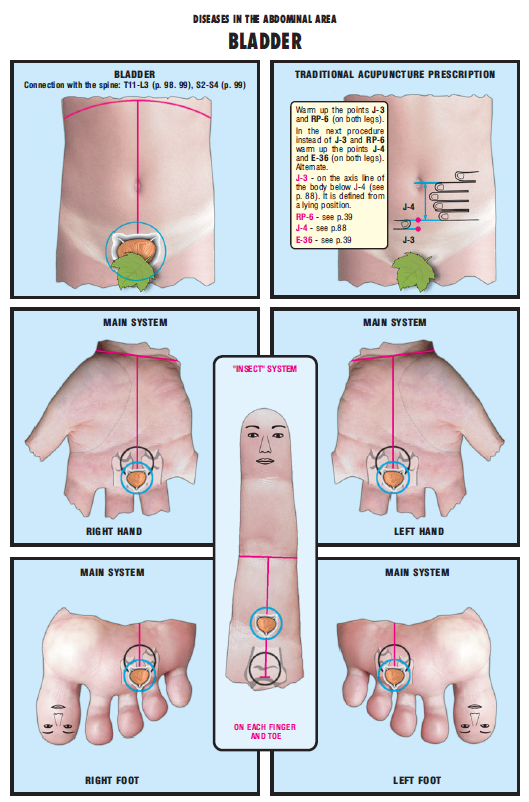
Sujok Prescription for Bladder 41

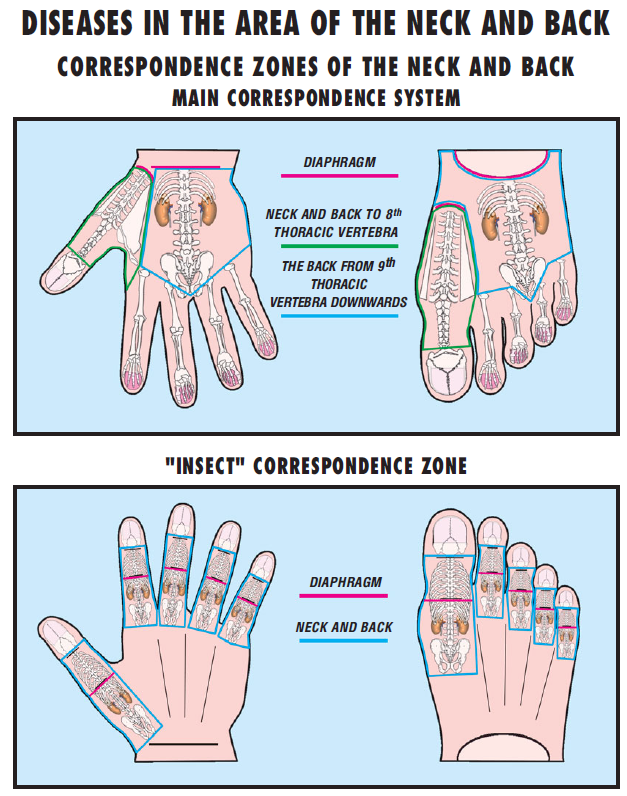
Sujok Prescription for Neck and Back 42
The back and the nape of the neck are projected on the upper part of the hand and foot.
In the Main system the projection of the back is divided into two parts. On the thumbs and the big toes the neck (on the second phalanx) and the part of the back to the 8th thoracic vertebra (on the first bone before the wrist and the first bone before the foot) are projected. The rest of the back, from the 9th thoracic vertebra downwards, is projected on the adjoining to the thumbs upper part of the palm and the foot.
In the “Insect” system the neck is projected on a small area between the first and second phalanges of the fingers and toes. On the middle phalanges of the fingers and toes the part of the back from 8th thoracic vertebra is projected, and on the proximal (third) phalanx – the part of the back from 9th thoracic vertebra downwards.

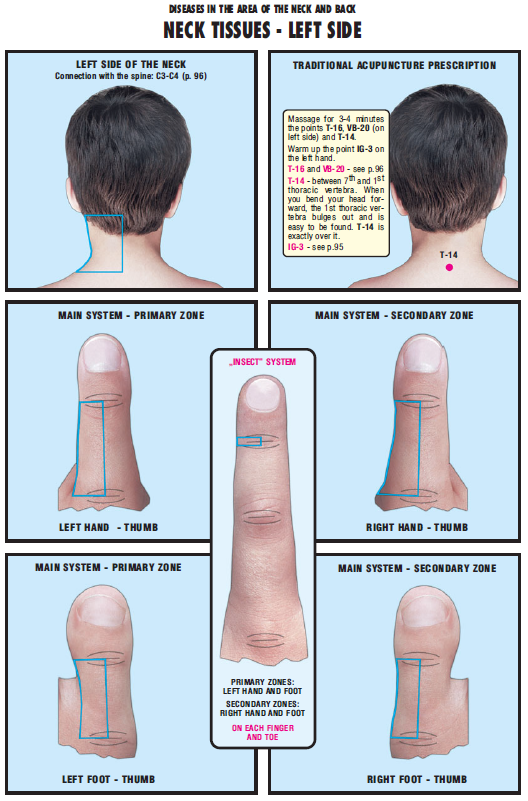
Sujok Prescription for Neck Tissues-Left Side 43


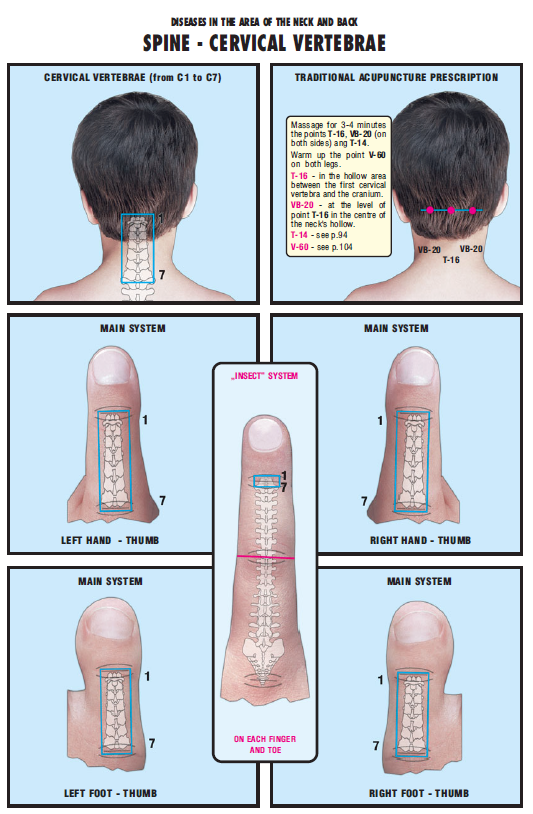
Sujok Prescription for Spine- Cervical Vertebrae 44

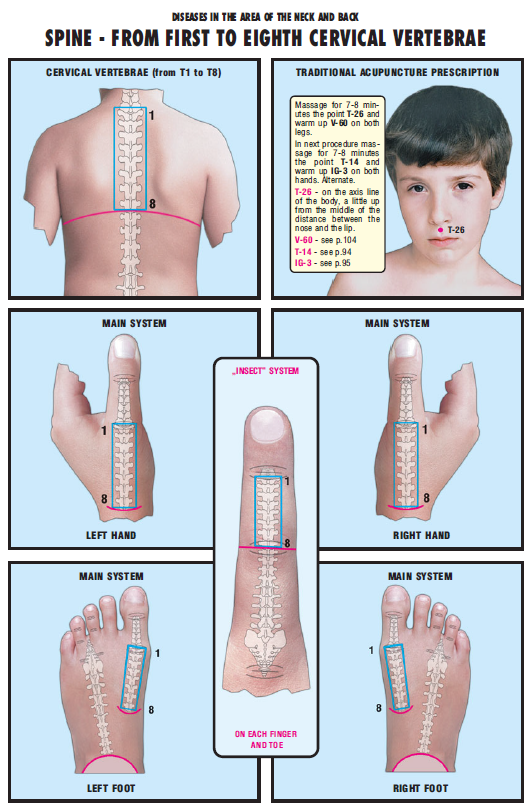
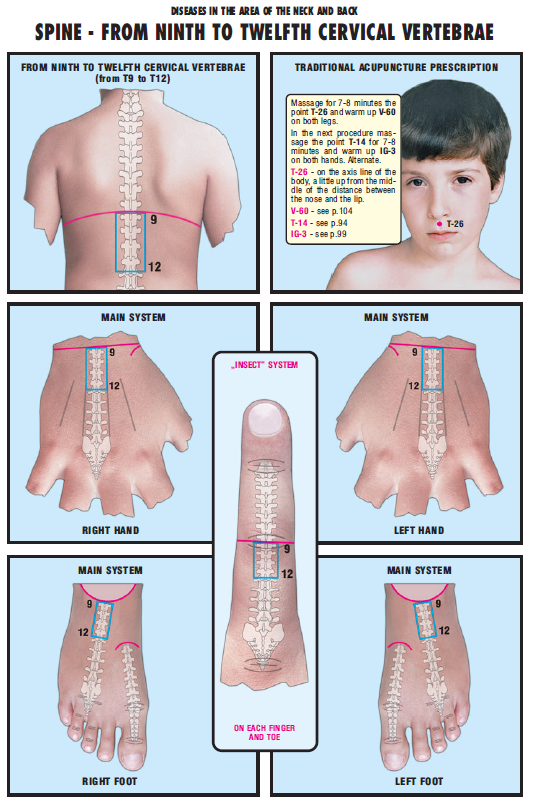
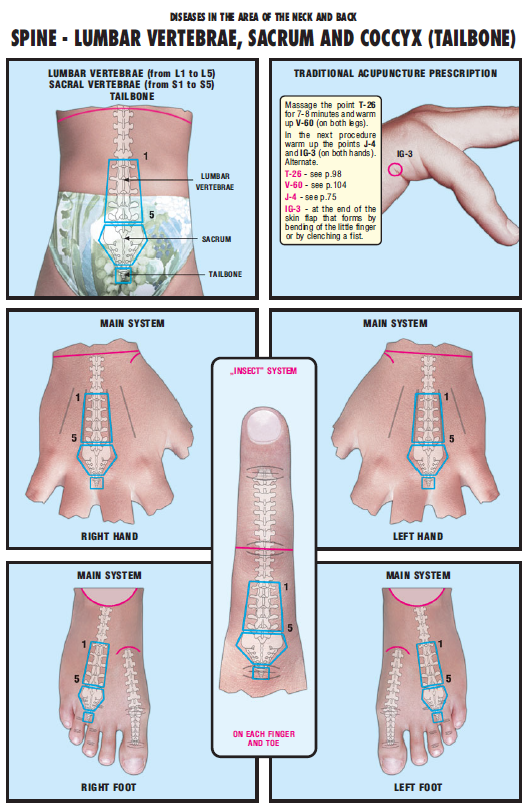
Sujok Prescription for Lumbar Vertebrae, Sacrum & Coccyx 45

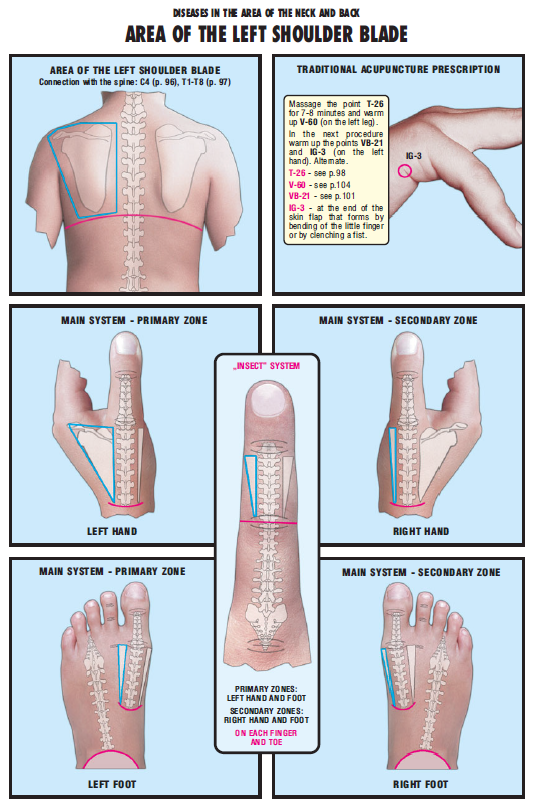
Sujok Prescription for Area of Shoulder Blade 46

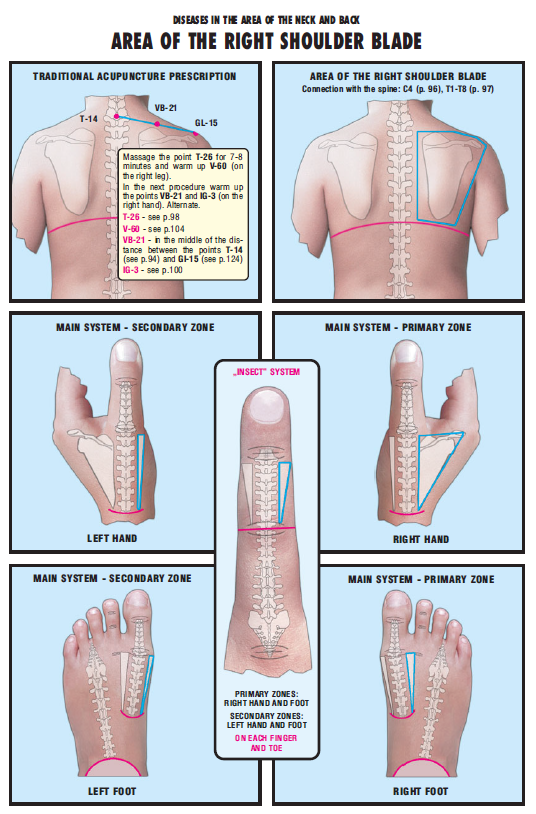
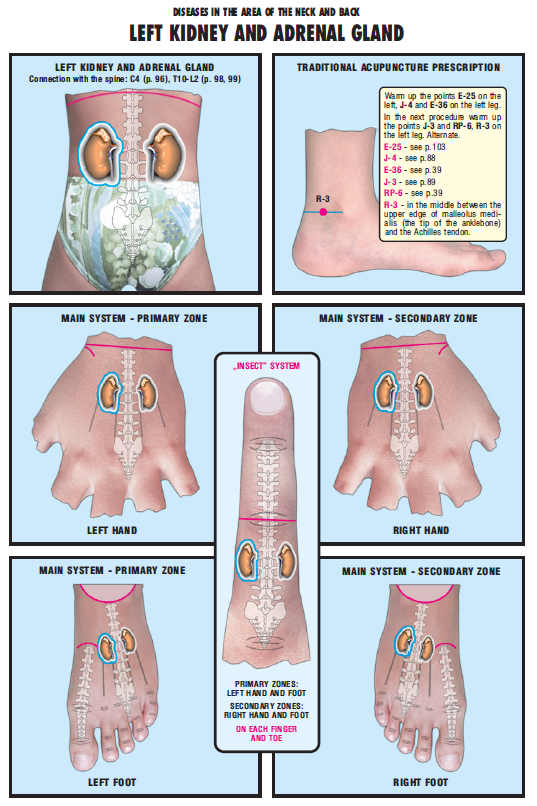
Sujok Prescription for Kidney & Adrenal Gland 47

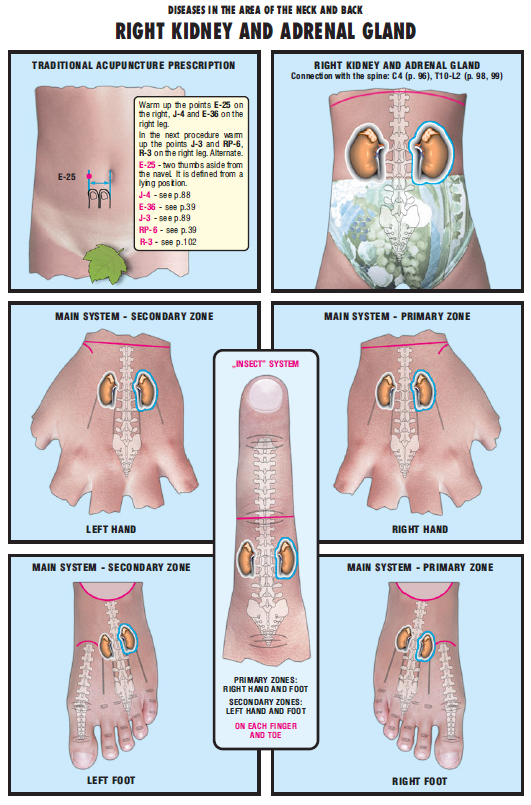
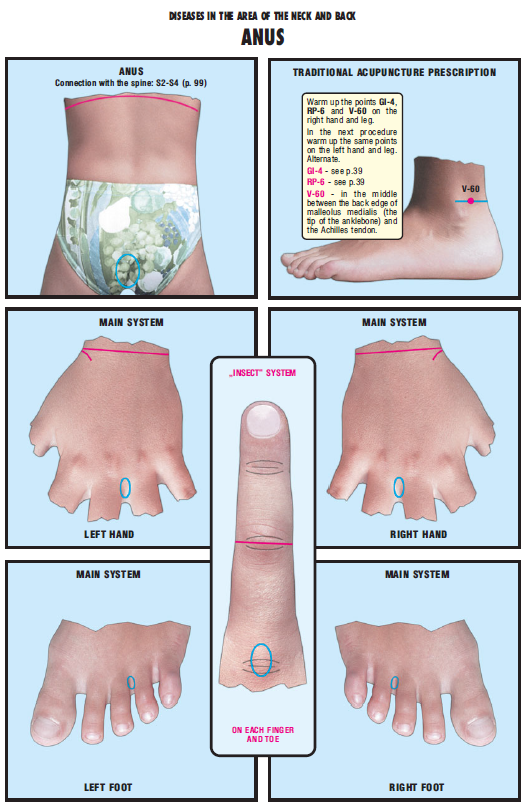
Sujok Prescription for Anus 48

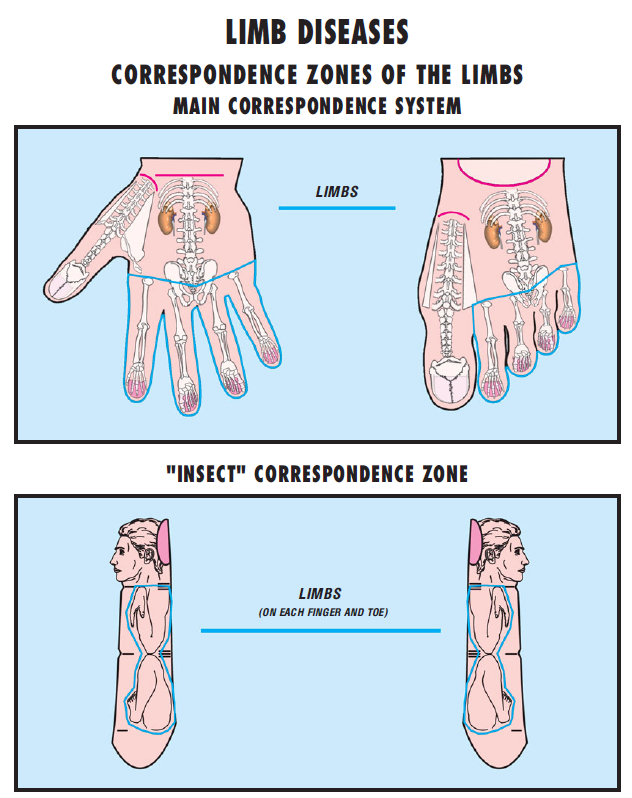
Sujok Prescription for Limb Diseases 49
In the Main system the limbs are projected on the fingers and toes (without the thumbs).
The upper limbs are projected on the second and fifth finger (toe), and the lower – on the third and fourth finger and toe. The hands and feet are projected on the distal (first) phalanges of the fingers (toes). The forearms and shanks – on the middle phalanges of the fingers (toes). The armpits and thighs – on the proximal (third) phalanges of the fingers (toes). The knuckles correspond exactly to the joints of the hands and feet.
In the “Insect” system the limbs are presented in a bent position, on the side parts of the second and third phalanges of all the fingers and toes. The hands are projected on the side parts of the middle phalanges of the fingers (toes).

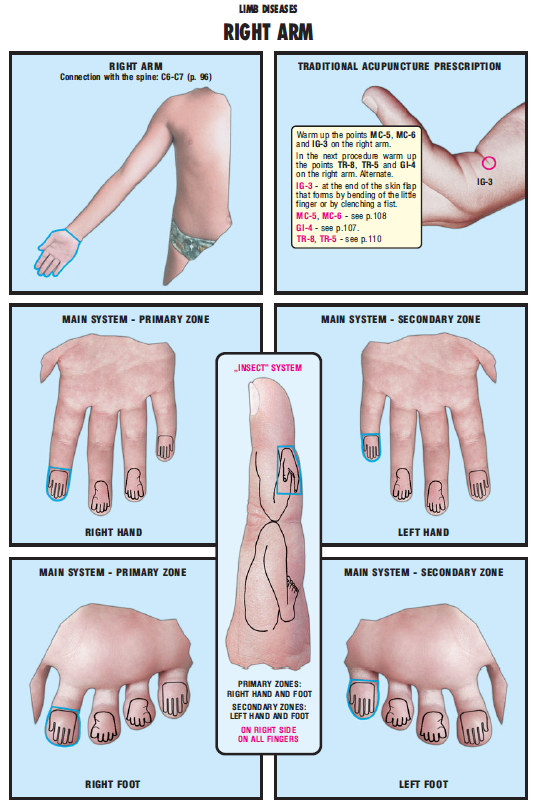
Sujok Prescription for Arm 50


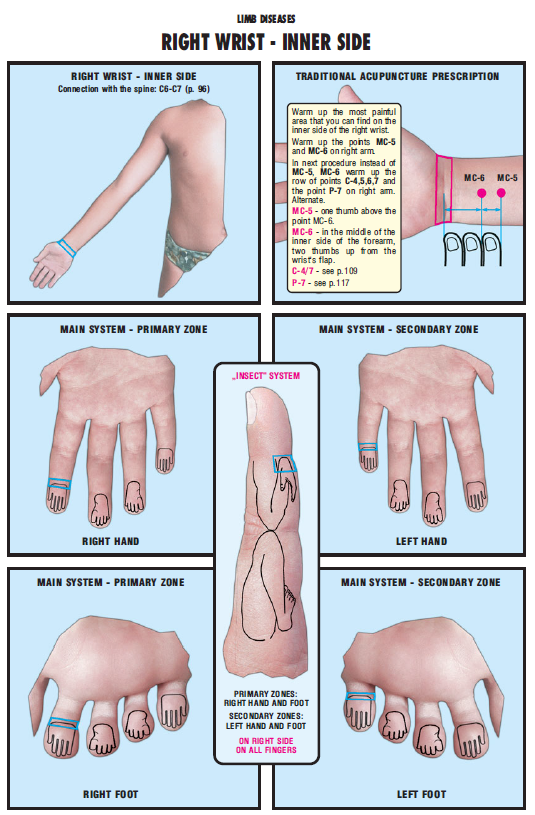
Sujok Prescription for Wrist 51

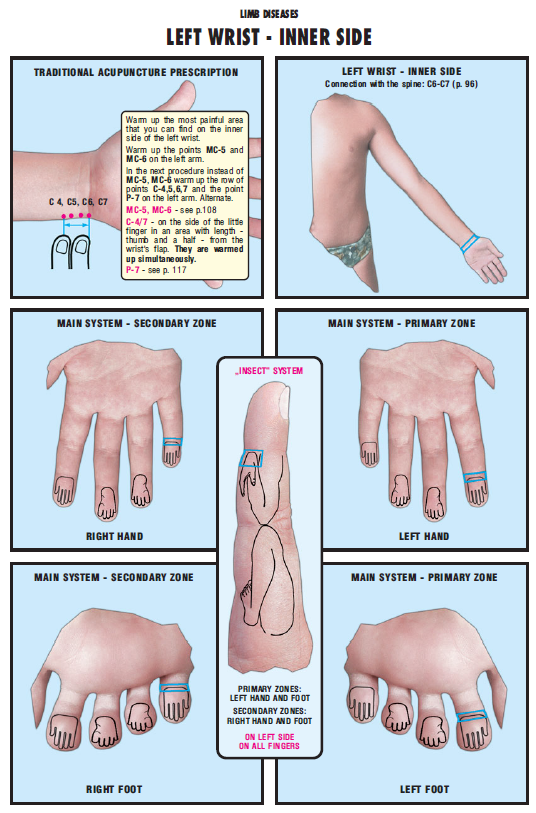
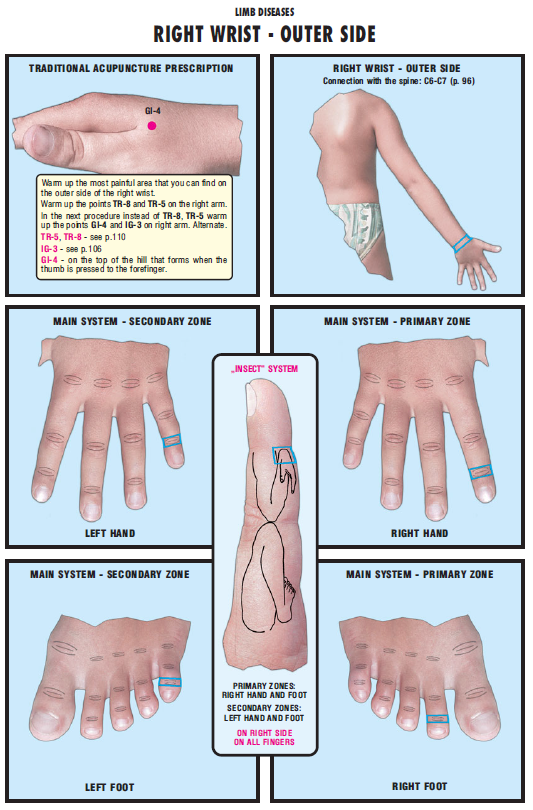
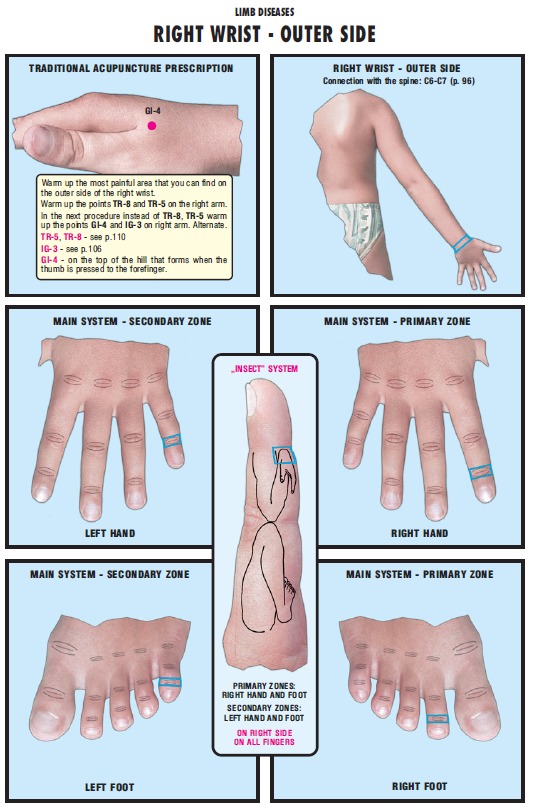
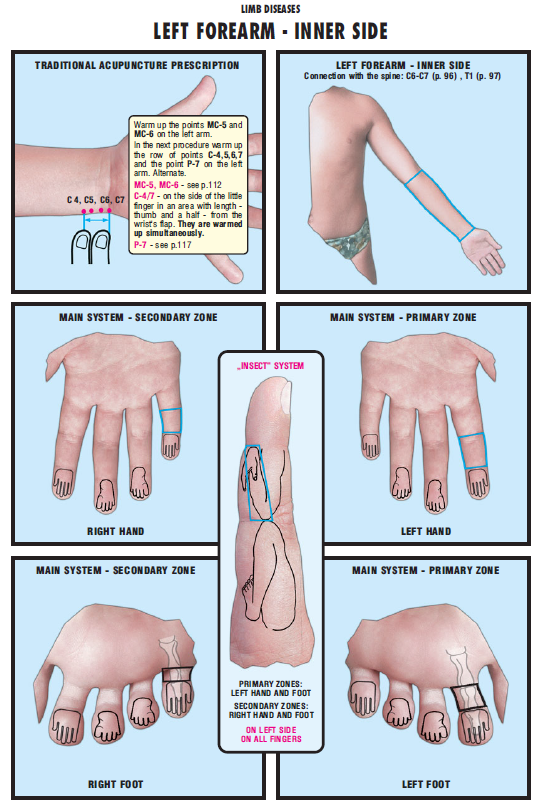
Sujok Prescription for Forearm 52

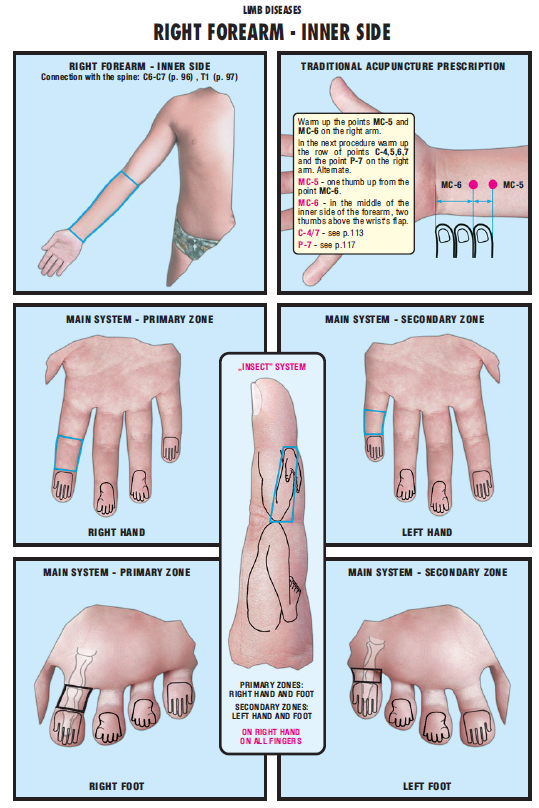
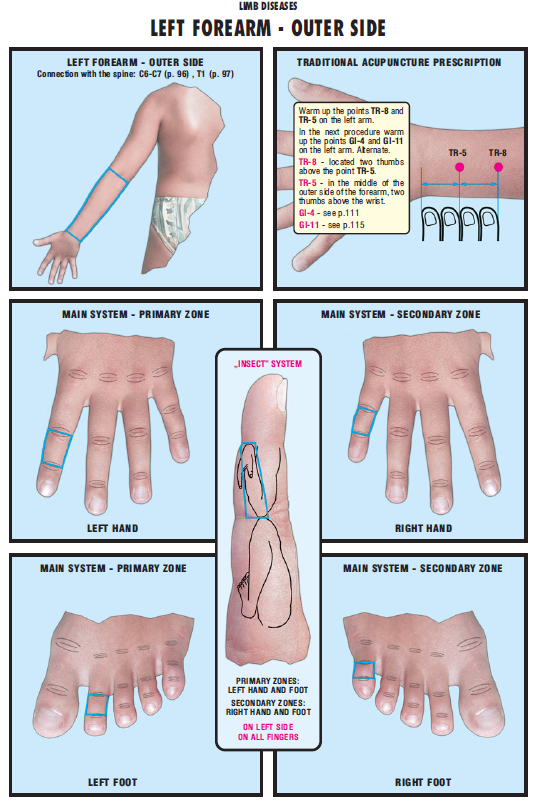
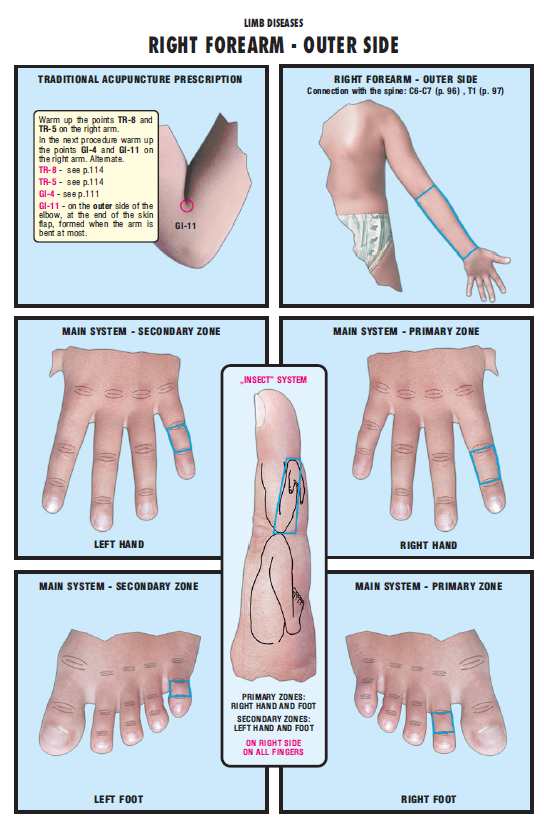
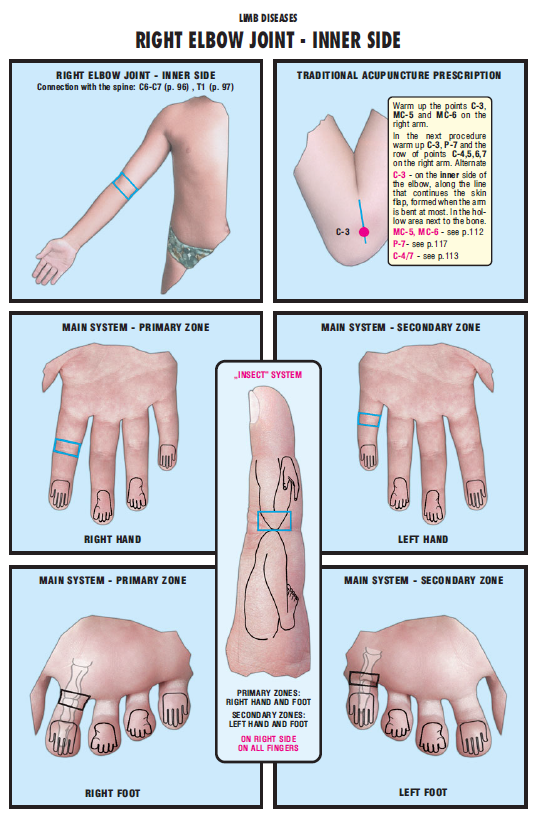
Sujok Prescription for Elbow Joint 53

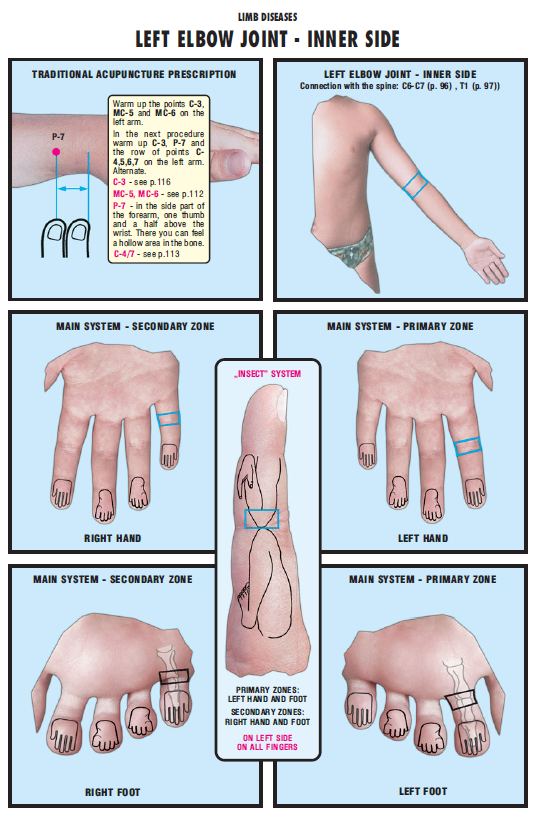
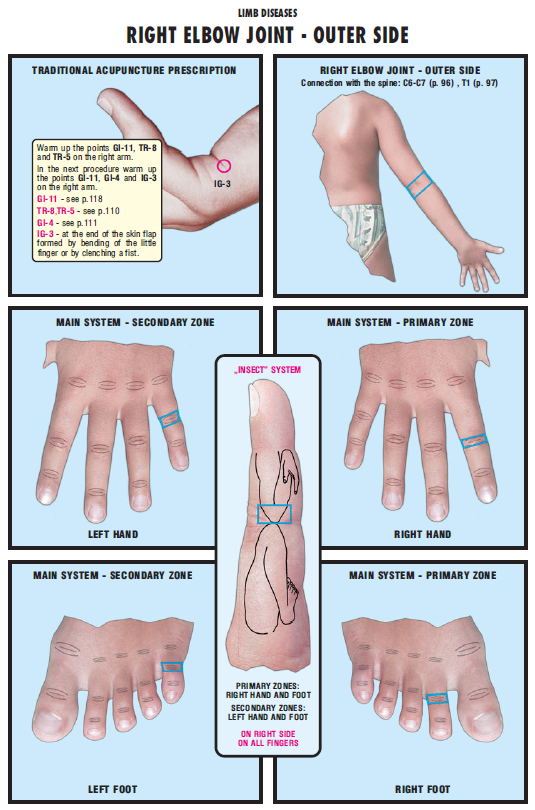
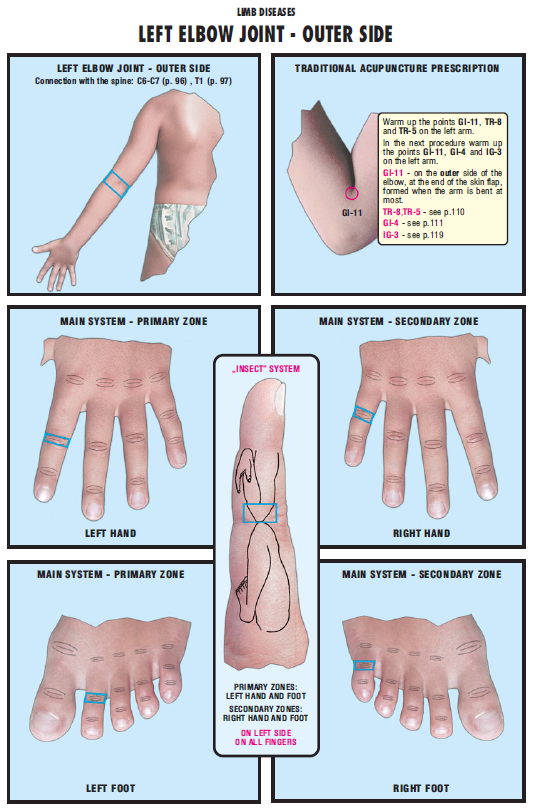
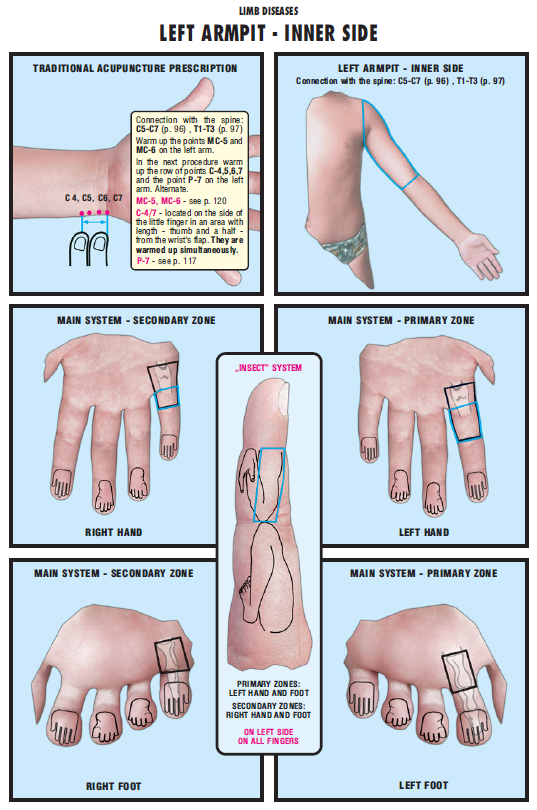
Sujok Prescription for Armpit 54

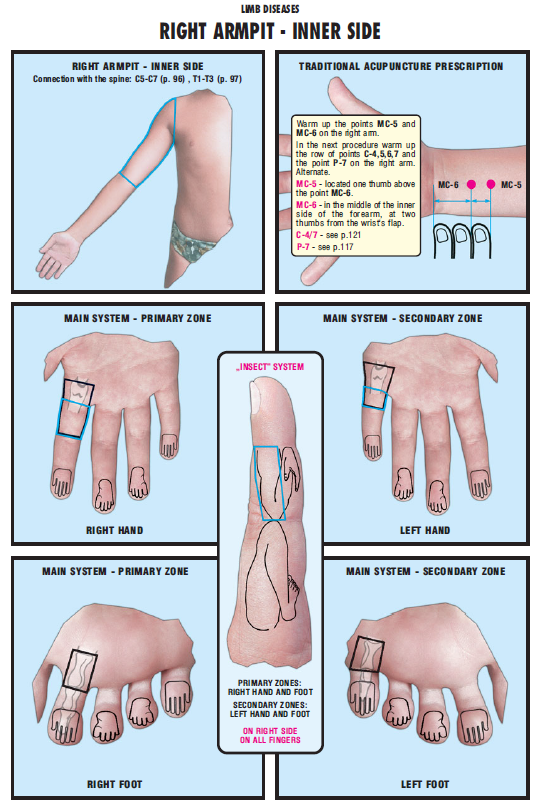
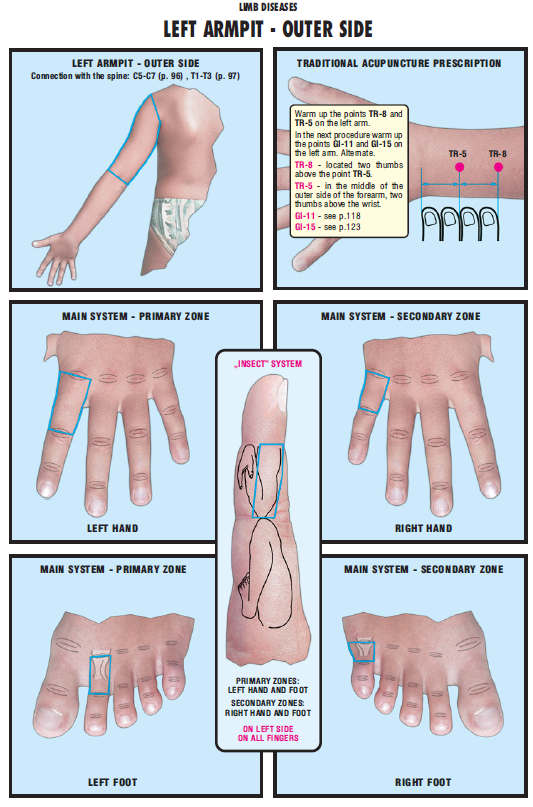
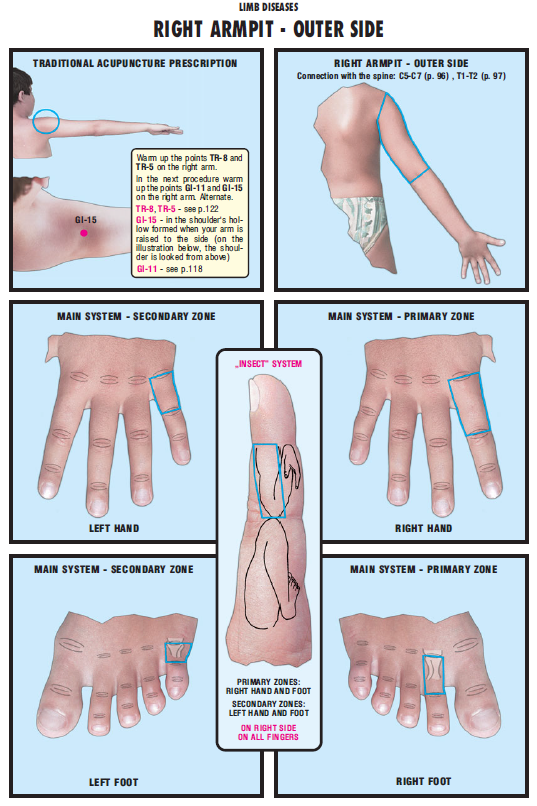

Sujok Prescription for Shoulder Joint 55

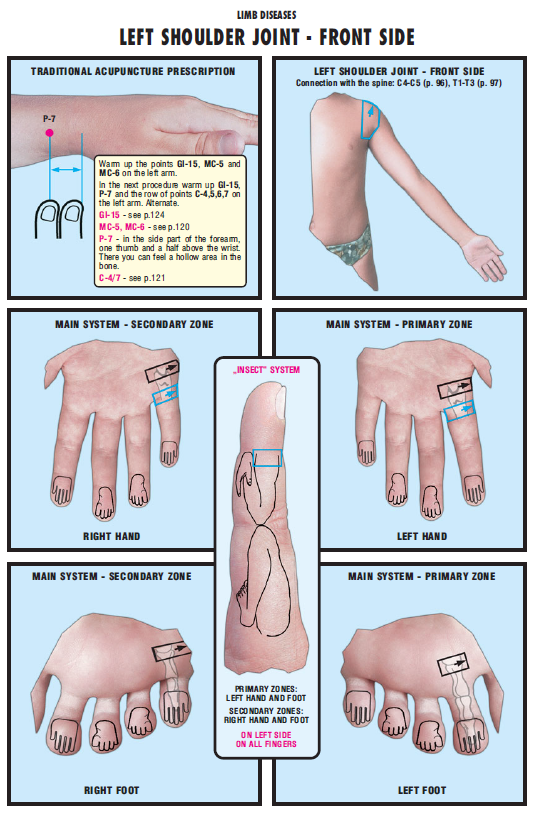
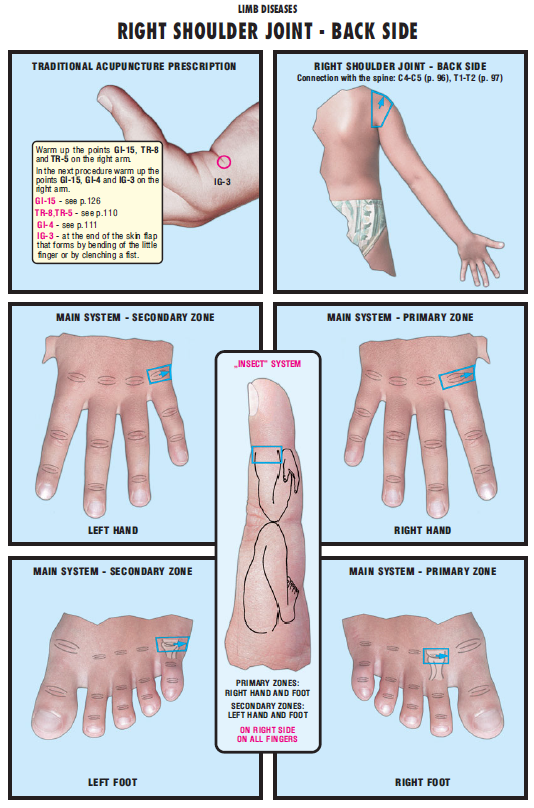

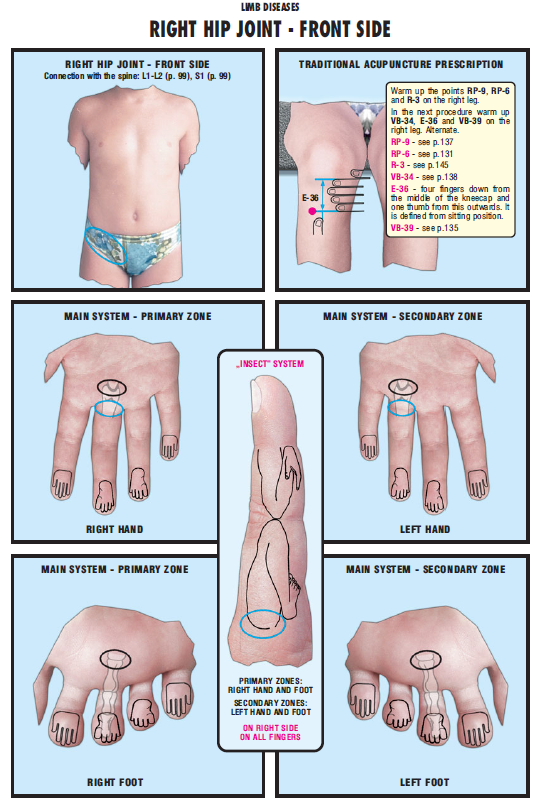
Sujok Prescription for Hip Joint 56

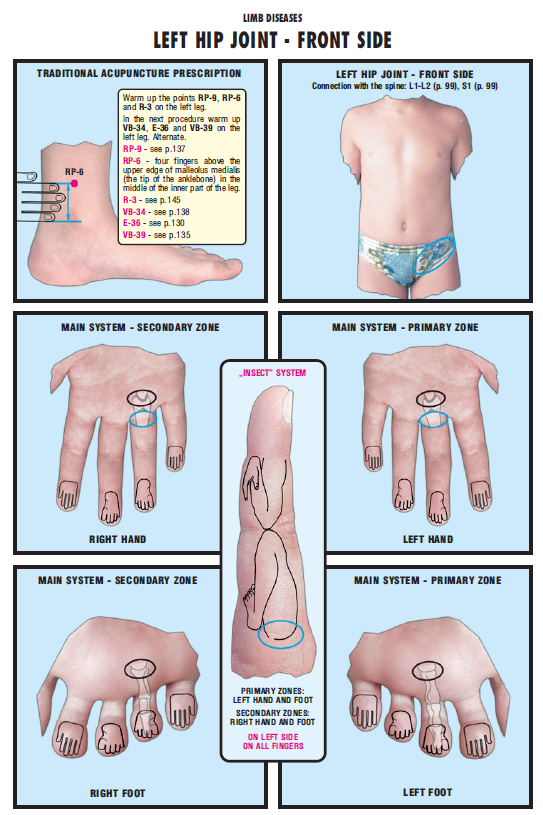
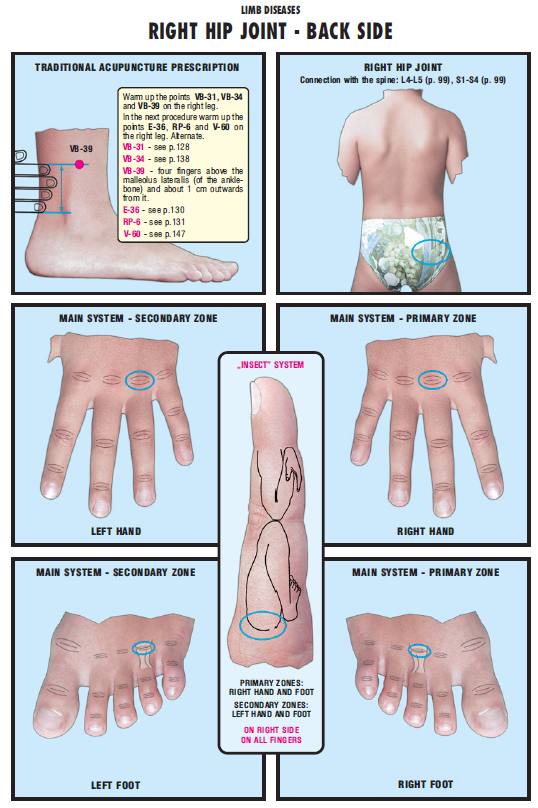
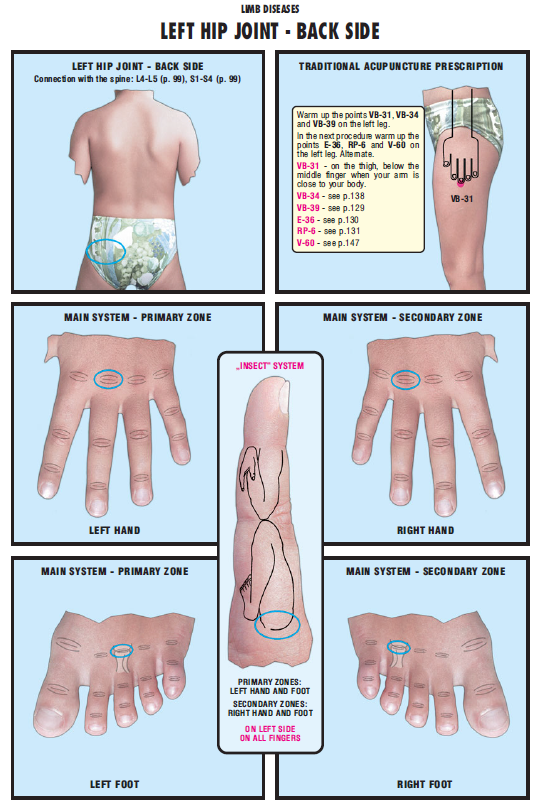
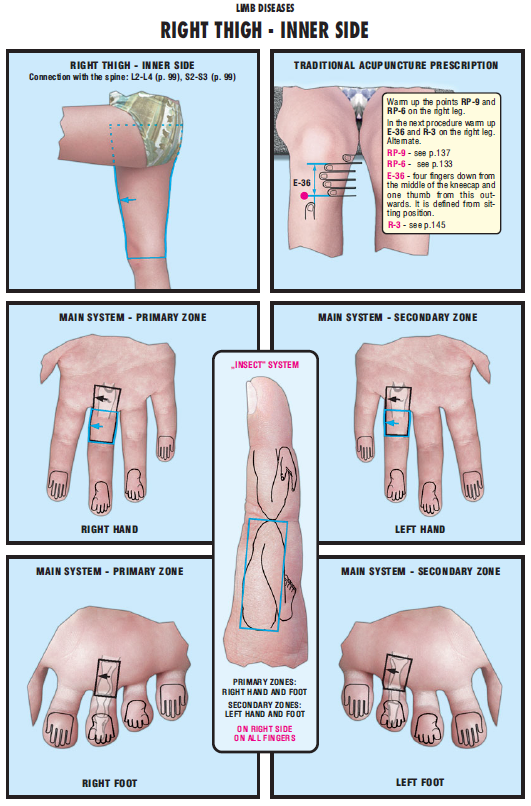
Sujok Prescription for Thigh 57

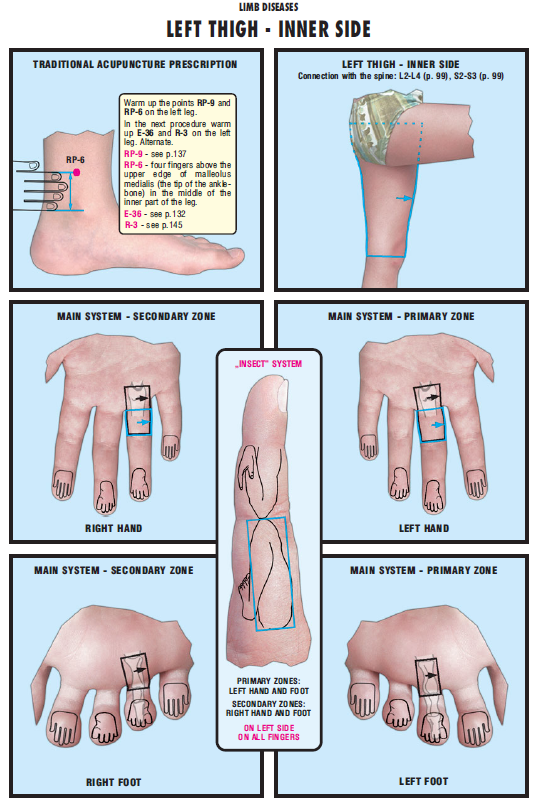
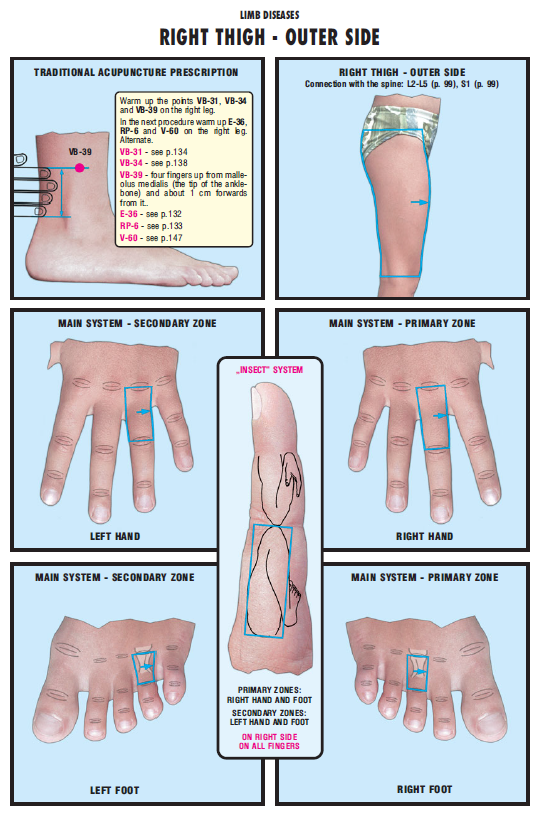
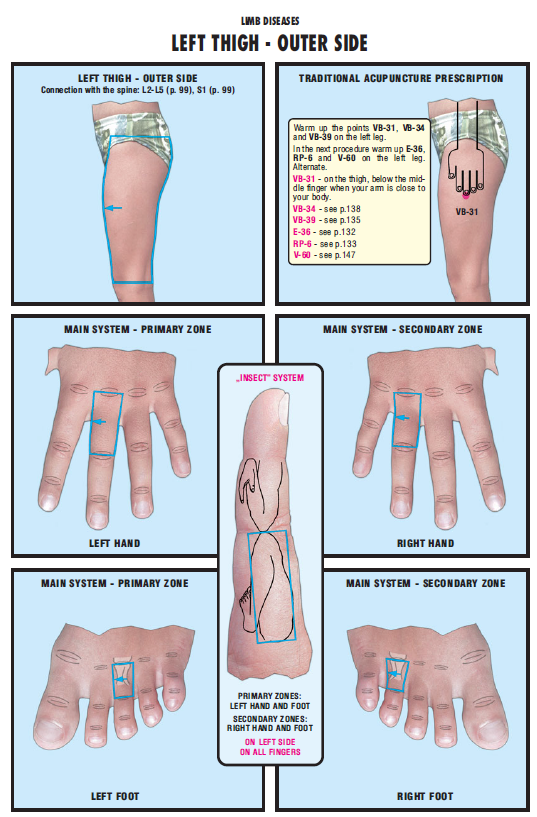
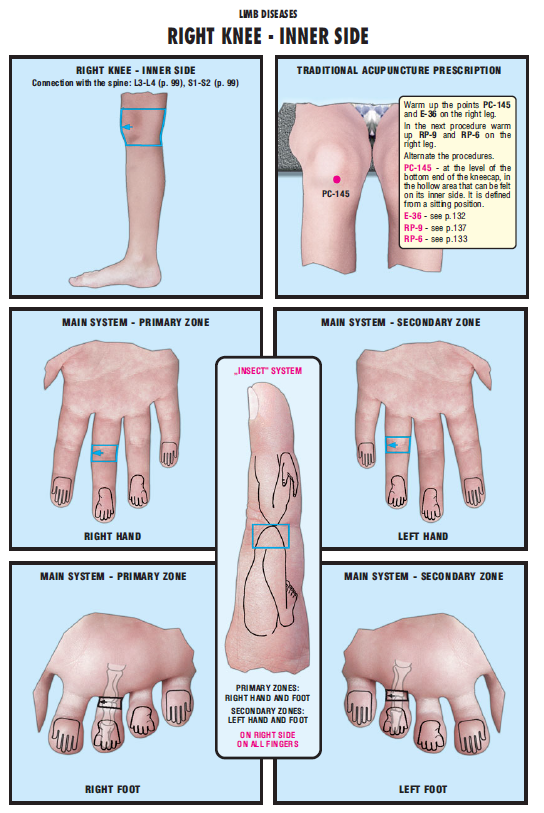
Sujok Prescription for Knee 58

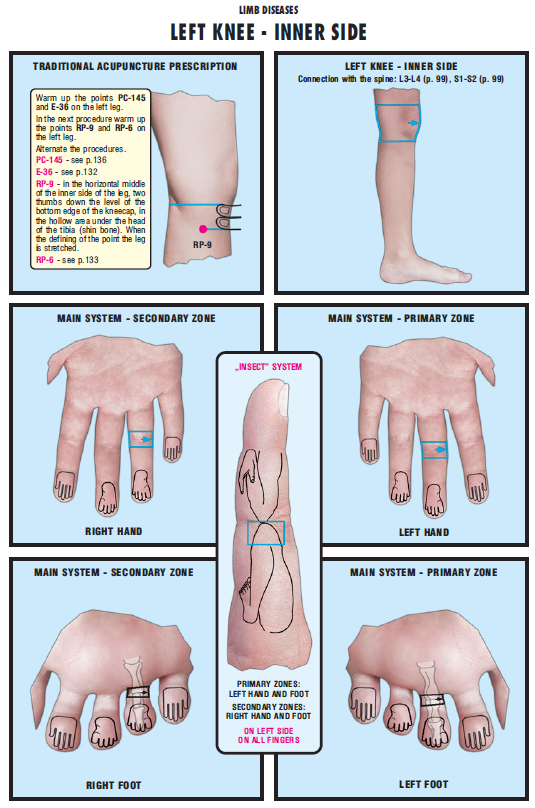
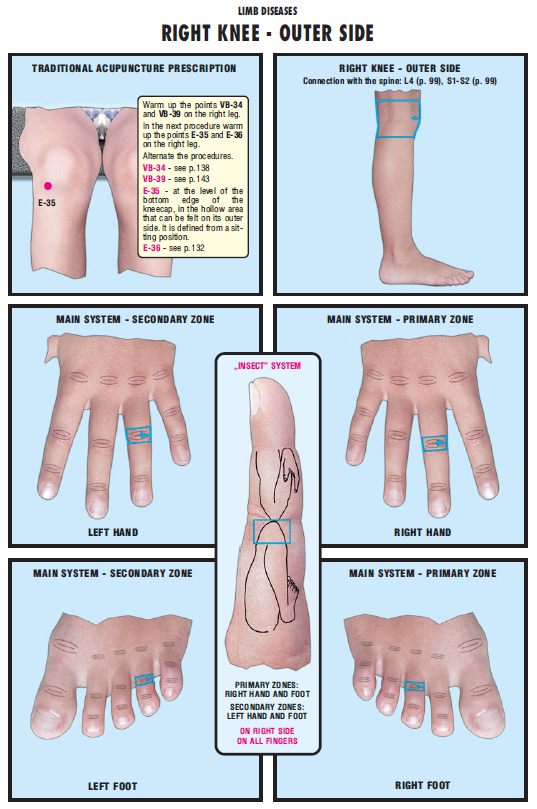

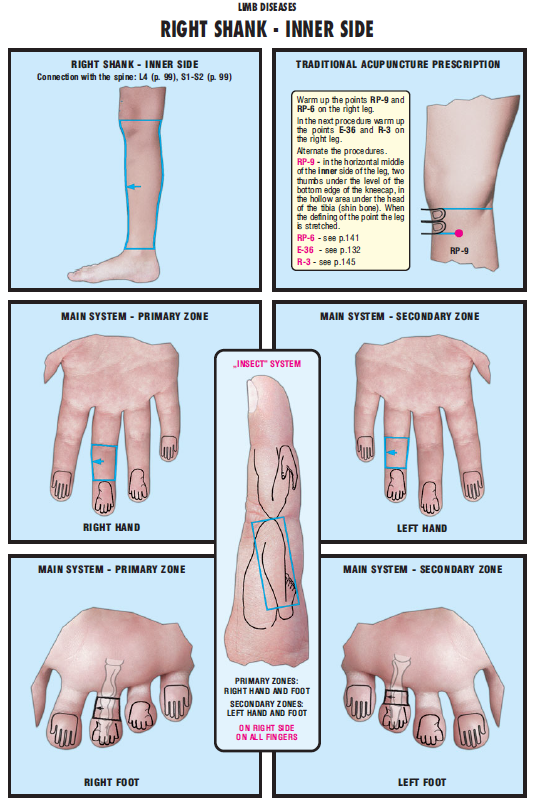
Sujok Prescription for Shank 59

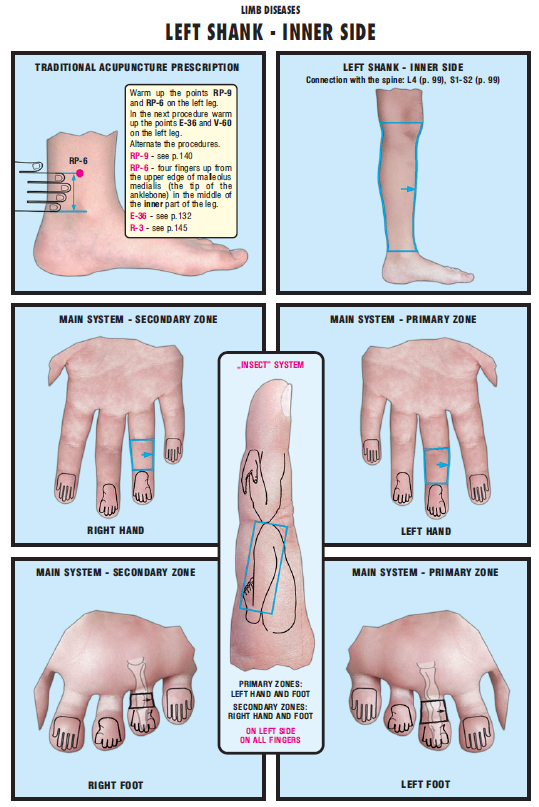
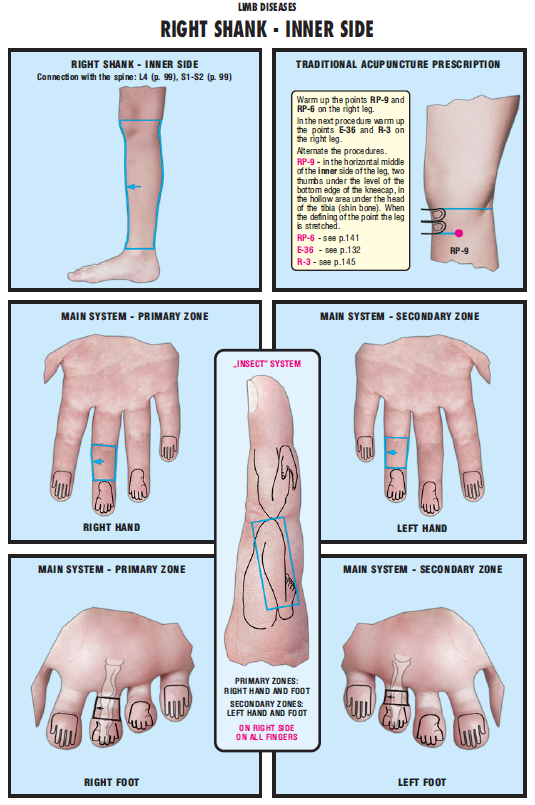
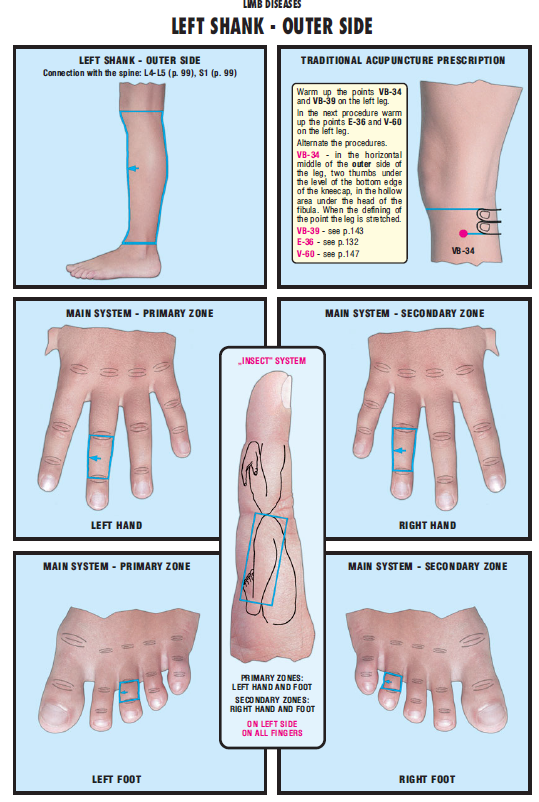
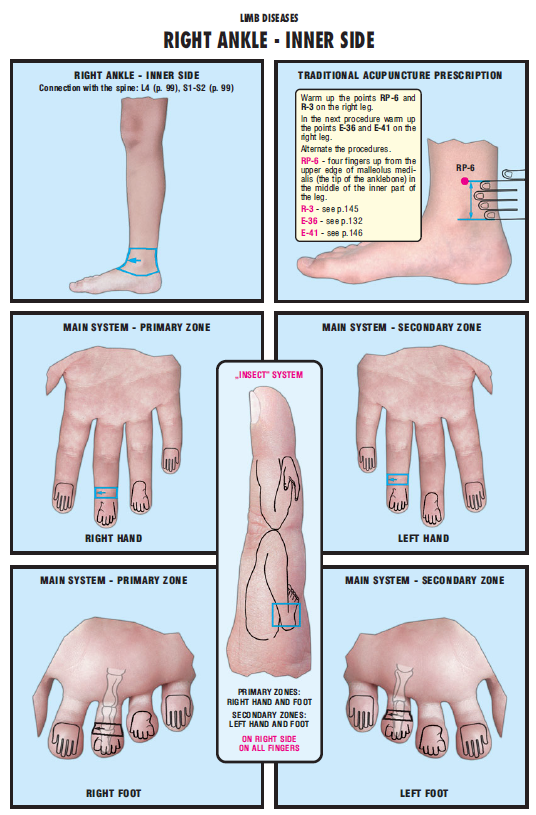
Sujok Prescription for Ankle 60

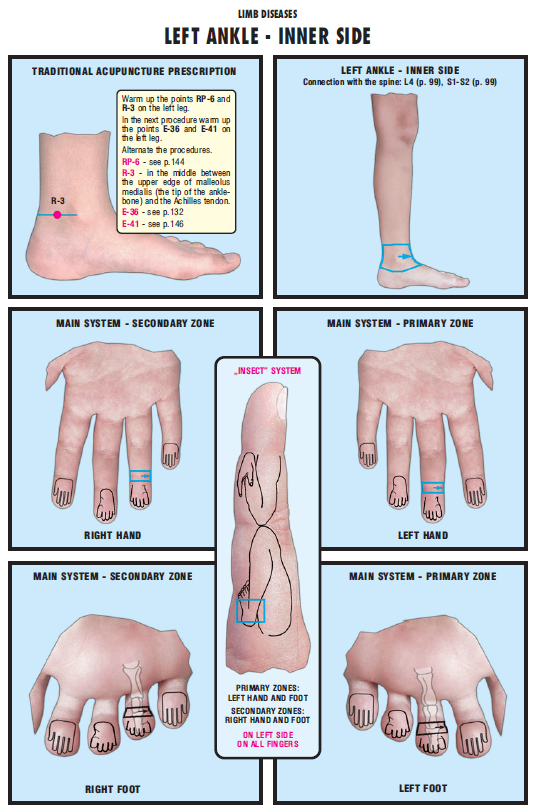
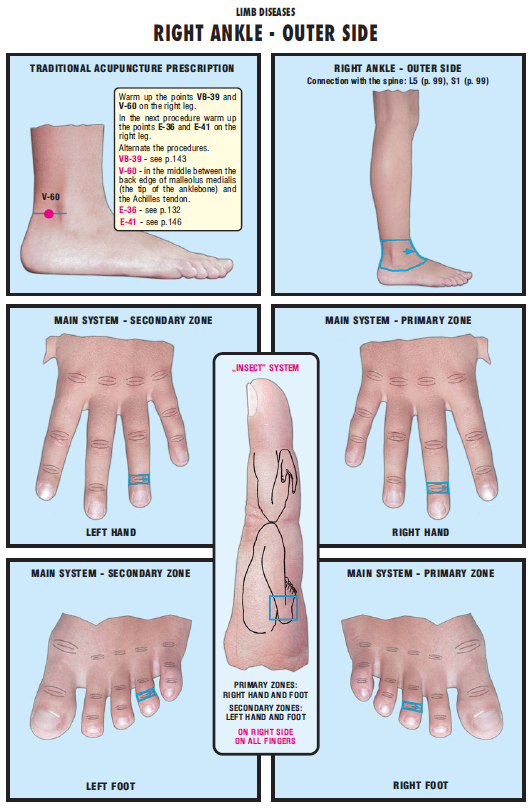
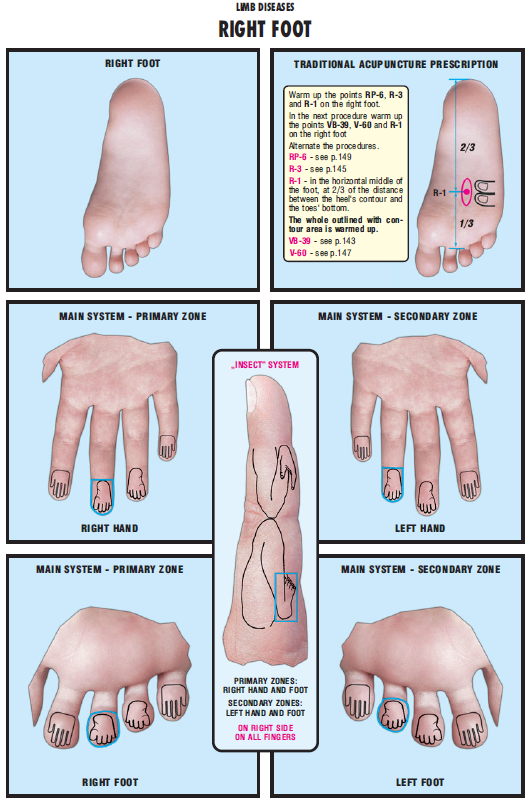
Sujok Prescription for Foot 61

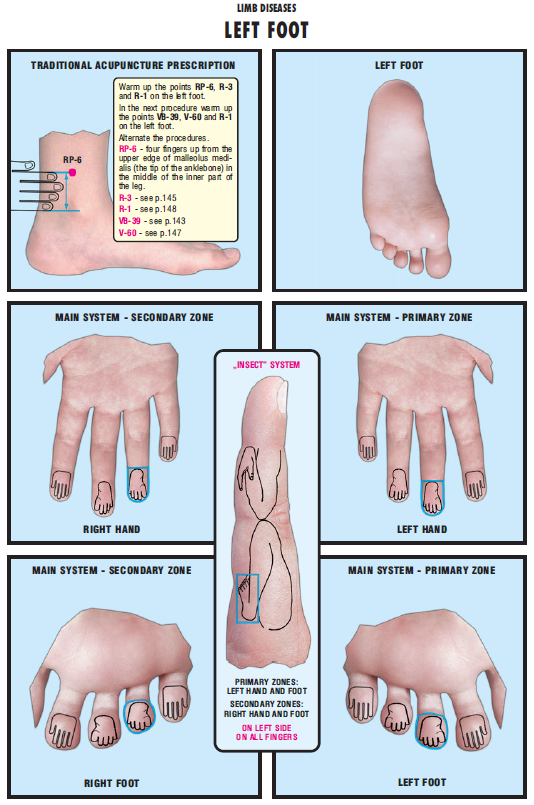
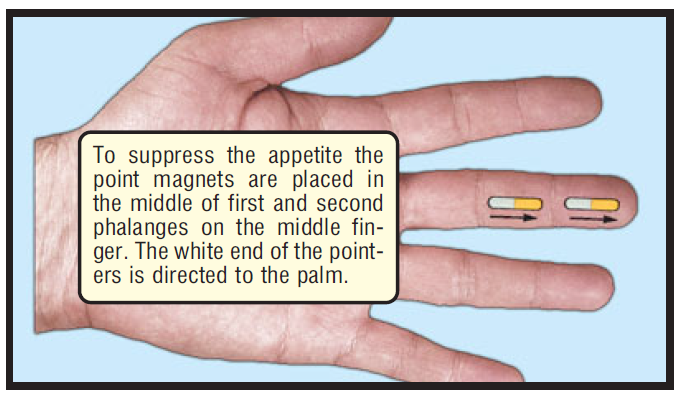
Sujok Prescription for Weight Loss 62
WEIGHT LOSS WITH SU JOK
Weight Loss is possible due to the placing of magnetic pointers on correspondence zones of the esophagus and rhinopharynx so that the vector of their magnetic field to be directed against the food motion. It is recommended to use the middle fingers because the meridian of the pancreas passes there, and that has a direct influence over the appetite and digestion. Placed like this, the point magnets suppress the appetite.
The pointers are placed in the middle of the first and second phalanges of the middle fingers and are attached with an adhesive tape. They are worn during the day and removed in the evening. It is conceivable the people that are more sensitive to magnetic field to feel dizzy. In this case only one pointer is placed on each middle phalanx of the middle fingers. The pointers are placed every day till the desired weight is achieved. For best results it is normal to lose 2 kg monthly.
The author considers this method as the most efficient out of all known methods for appetite regulation – drugs, herbs, acupuncture etc. The pointers suppress the appetite and this can be felt even in the first hours after they are placed. Gradually the centre of the appetite in the brain „reprograms“ itself and starts demanding less food in conformity with the real needs of the organism. This readjustment is permanent and (in contrast to all other diets and methods for losing weight) does not change even after you’ve reached the desired weight and you’ve stopped being on a diet.
Nevertheless, keep in mind that to reduce your weight you must follow a diet, approved by a doctor, by effort of will. The magnetic pointers will just help you surmount easier the first days of the diet and to make the achieved result stable. In other case, if you rely only on the pointers and you are not ready to try hard to lose weight it will happen as it happened with my stout friend who said, “Yes, the pointers suppressed my appetite. Now I eat as before but everything seems disgusting… ”

The prescription guide consists of:
- Maps of the correspondence zones in the two systems – the Main and the “Insect” correspondence system.
- Traditional acupuncture prescriptions with maps of the location of the prescription’s acupoints.
To treat yourself using the guide, you have to specify the contents of the healing procedure and to accomplish it using the correspondence zones maps of the affected organ, and when necessary you will also have to include the traditional acupuncture prescription published on the same page.
In this particular case you have two choices:
The first choice is to build the contents of the healing procedure by yourself, based on the information presented so far, the correspondence zones maps, the traditional acupuncture prescriptions and using your own intelligence.
The second one is to use the standard healing procedure.

BUILDING THE HEALING PROCEDURE
Let’s remind in brief what you have to do in case you decide to build the contents of the healing procedure by yourself (for details refer to the corresponding section).
1. You have to select one to four correspondence zones of the diseased organ in which you have to look for pain points or areas.
Make the choice considering the basic principles used for selection of correspondence zones.
It is necessary to notice that despite the great effectiveness of those zones located on the feet, due to the better comfort and the easier definition of the correspondence zones the hands are used more often in the real practice. Primary and secondary correspondence zones are combined on both of the hands.
Besides, sometimes the use of secondary instead of the primary zones is more comfortable. Such an example is the case with the zones of the blade-bones in the Main correspondence system. The secondary zones of the blade- bones are located over a bone thus the pain points there are easier to find. That is why they are used more frequently.
2. In case of more serious and refractory chronic diseases you have to include pain points in additional correspondence zones.
These are the correspondence zones of the spinal column, the brain and internal organs, directly related to the diseased organ.
3. You have to take a decision whether you will use mirrored pain points or not.
Here you have to decide whether you will use mirrored points, besides the main su jok points and if yes, which one – horizontal or vertical. You won’t make a mistake if you include them.
4. You have to select a stimulation method of the pain points and areas.
The stimulation methods are divided conditionally in two categories:
- Methods of relatively short but powerful stimulation.
These are diagnostic probe massage, moxa (or ice), needles, hot needles.
- Methods of long and soft stimulation.
These are seeds, magnetic stars, magnets.
You’d better combine methods of stimulation from both of the categories.
5. According to the seriousness of the disease, use your own judgment to decide whether to include the traditional acupuncture prescription.
At this point don’t forget that the traditional acupuncture prescriptions might also be used independently.
If the making up of the healing procedure hampers you, use the standard healing procedure which we suggest in the “Prescriptions” section in the images below. It has been tested many times and the results have been excellent, including the cases of serious chronic diseases.
GENERAL ADVICES AND NOTES
- It is recommended to treat one diseased organ or part of the body. If you have several diseases, then you have to select the one that concerns you the most. The distribution of healing impulses among many organs decreases their effectiveness.
- It is possible to treat two diseased organs simultaneously by alternating the healing procedures. For example: on the first day – kidneys, on the second day – bladder etc.
- If symmetric organs or parts of the body are diseased, for example the two kidneys or the two knees, you can heal them by alternating procedures for the left and for the right side.
- In case of acute illnesses expect the healing effect to show itself by the third-fifth procedure, although often with the very first procedure and even in the first seconds of the stimulation a clearly expressed healing effect and sometimes even a complete fade away of the disease’s symptoms might be observed. In the cases of chronic diseases the healing effect might be felt for a first time by the seventh-eighth procedure.
In some cases it is possible to feel no improvement at the time of the healing course and the disease can fade away suddenly, several days or weeks after its finish. The reason is that the stimulation upon the correspondence zones gives a push for the healing changes, which sometimes accelerate very slowly and can not be felt in the term of ten days which are needed for the procedures.
- In the course of the healing procedures you might get a disease aggravation. That is the so called “healing crisis”. This shouldn’t worry you. Remember, the su jok therapy can’t do any harm to you!
- When you stimulate the pain points you must also stimulate the secondary pain points, which sometimes appear near to the main, most painful point.
NOTES AND ADVICES ON THE CORRESPONDENCE ZONES MAPS
- We have developed maps of the correspondence zones for almost every organ and part of the body.
For each correspondence zone in the Main system we’ve developed a separate map.
We have shown the correspondence zones in the “Insect” system summarized on a single finger, as they are located in the same way on all fingers and toes. Slightly different is the case with the thumbs in the “Insect” system. In contrast to the other fingers, the thumbs have two phalanges – distal (first) and proximal (second). The system is projected over the first phalanx (the head and neck zone) and the second phalanx (thorax zone). The role of the third phalanx is performed by the first bone before the wrist for the hands, and the first bone before the foot for the feet (stomach zone).
The determination of the correspondence zones by the “Insect” system might hamper and confuse you. For that reason use the remaining four fingers and toes. They are fairly enough.
We have marked the correspondence zone in the following manner:
- We have marked the areas where the skin and bone correspondence coincide with blue outline.
- In the places where the skin and bone correspondence don’t coincide we have used blue outline for the skin and black outline for the bone correspondence.
- In some of the correspondence zones in which the skin correspondence is not clearly expressed – for example on the bottom of the toes, we have outlined only the bone correspondence with black contour.
Keep in mind that in some cases the contour on the map doesn’t outline the exact borders of the correspondence zone. For example the stomach zone may be smaller for some people and larger for others according to the size of the stomach itself. That is why you must also search for the pain points around the borders outlined on the map.
- We haven’t developed maps of the primary and secondary correspondence zones for some unpaired organs located on the body axis. We’ve only shown their location on the both hands and feet. The correspondence zones of the spinal column or the thymus are such an example. In theory, their halves have primary and secondary correspondence, and you can guess by yourself how to determine and use it.
- In the process of location of the correspondence zones on your own hands and feet, the best way to keep yourself from making a mistake with left and right is to use your imagination and to lay your hand or foot on the place of the illustration.
NOTES AND ADVICES ON THE TRADITIONAL ACUPUNCTURE PRESCRIPTIONS
We have included mostly ancient Chinese prescriptions from traditional acupoints as well as some popular contemporary prescriptions recommended by competent acupuncture specialists. These prescriptions can be used in parallel with the su jok therapy or independently.
We’ve made our best to collect combinations, consisting of acupoints whose location can be determined easily by inexperienced people.
Keep in mind that our manual is for self-treatment, so we haven’t included points on the back which can not be stimulated independently, without someone’s help (despite their high effectiveness).
The basic measuring units by the location of the acupoints are:
- The width of YOUR hand’s thumb in the place of the knuckle between the first and the second phalanx. In the traditional acupuncture this width is called individual tsun.
- The width of YOUR gathered four fingers of the hand (without the thumb) in the place of the knuckle between the middle and the third phalanx of the middle finger. The width there equals to three individual tsuns.
In the illustrations these measuring units are shown by graphical pictograms.
When you use traditional acupuncture prescriptions don’t forget the following:
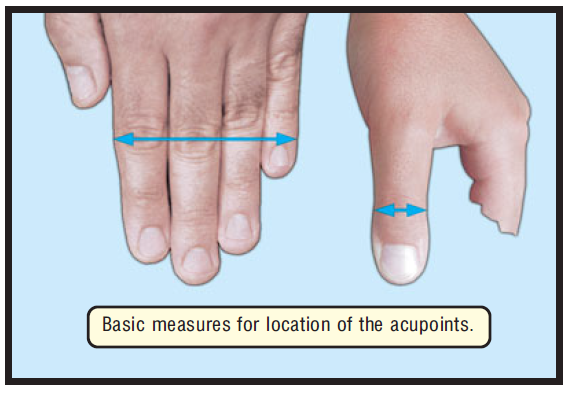
- If you’ve located the place of the acupoint correctly, by strong vertical pressure with the thumb’s tip or with the thicker end of the diagnostic probe you must experience “the expected sensations” – pain, tingle, twitch etc. Be sure to do this check.
- Stimulate the acupoints with moxa for 10-12 minutes. If you clearly feel that a longer heat treatment will have a positive effect on you, you may prolong it up to 20 minutes.
- In some cases when the acupoints are on the face, in the hair or the warming up is not allowed, the recommended action is massage stimulation on these points.
- Warm up the acupoints in the sequence specified in the prescriptions. Usually the points on the axis of the body are warmed up at first, then all the other – from above downwards.
A STANDARD HEALING PROCEDURE
The standard healing procedure consists of two parts. The first one is performed in the case of the most usual diseases. The second part is added to the first one in cases of more acute or chronic diseases.
IN CASE OF USUAL DISEASES
- Locate the pain points in two correspondence zones of the diseased organ in the Main correspondence system and warm up them with moxa for 20-30 minutes.
To do this it is necessary to open the prescription guide on the corresponding page so you can become acquainted how the diseased organ’s correspondence zones are located on your hands and feet. You will have an exact idea of their location if you get a mental picture of your hand or foot in the place of the illustration.
After that outline the zones using a marker and go over them with the diagnostic probe. Mark the open pain points and warm them up with moxa.
It is advisable to use the primary correspondence zones – one on hand and one on foot (at the diseased organ’s side).
When the organ is located on the body axis, alternate the hands and feet in the separate procedures. For example: left hand – right foot in one procedure and right hand – left foot in the next one.
If it’s difficult for you to use the feet then use your both hands in each procedure.
Depending on the seriousness of the disease you may stimulate the su jok points with massage, needles or hot needles instead with moxa.
- Perform the traditional acupuncture prescription by heating the traditional acupoints for 10-12 minutes with moxa.
You will find the traditional acupuncture prescription on the page with the correspondence zones of the diseased organ. The location of one of the acupoints used in the prescription is shown there. You’ll find the other with the help of the references to other pages.
- Locate the pain points in two correspondence zones of the diseased organ in the “Insect” system (on two fingers) and put magnetic stars or seeds on them. Massage the points for 1-2 minutes on every 3-4 hours, using the magnetic stars or the seeds.
The “Insect” system is located likewise on all fingers and toes. For that reason there is a map of only one finger on the page containing the diseased organ’s correspondence zones. You will get an exact idea of the diseased organ’s correspondence zone location if you form a mental picture of the finger you want to use in the place of the illustration.
The magnetic stars (seeds) are put for 24 hours, till the next procedure with moxa when they are relocated on other two fingers.
Yet again it is advisable to use the primary correspondence zones of the diseased organ (one finger and a toe from the side of the diseased organ).
When the organ is located on the body axis alternate the fingers and the toes in the separate procedures. Left hand – right foot in one procedure, right hand – left foot in the next.
If you feel it’s difficult for you to use the toes, use only the fingers.
We strongly advise you not to ignore the magnetic stars (seeds). Their inclusion in the procedure is often a key to the fast overcoming of the disease.
The healing effect can increase vastly if you also put magnetic stars (seeds) on the mirrored pain points.
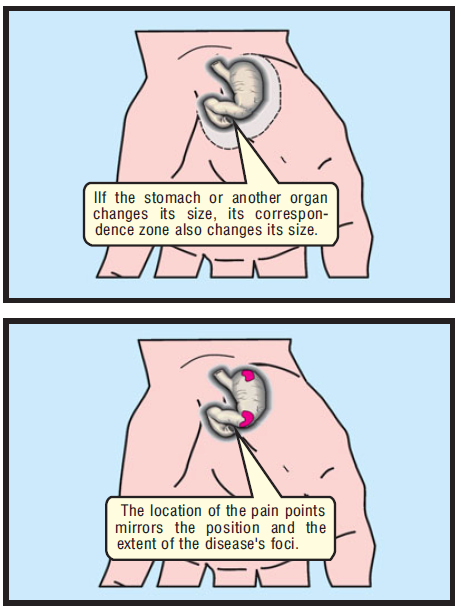
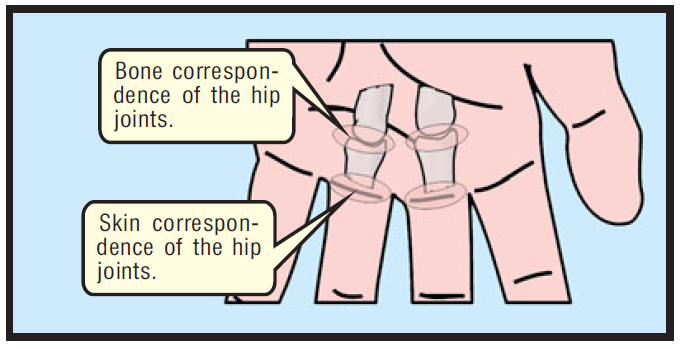
IN CASE OF MORE REFRACTORY, ACUTE AND CHRONIC DISEASES
- By using the “Insect” system, locate on two of your fingers pain points in the correspondence zones of the spinal column and brain, which are connected to the diseased organ. Massage them using a massage ring 2-3 times a day for 2-3 minutes.
Massage intensively the fingers with a massage ring by concentrating the massage in the areas in which you’ve found pain points. Massage each area on the two fingers 23 times a day for 2-3 minutes. On the next day use other two fingers.
If you experience difficulties with the location of the points just do a general massage of the fingers with the ring emphasizing on the areas in which you feel pain.
For more intensive stimulation instead with the massage ring you might influence on the open pain points with the magnetic stars or seeds.
* * *
This is a standard procedure which is effective for most of the diseases. However, you might “customize” it in accordance with the particular disease’s characteristics.
- You can use the separate elements of the procedure independently or in combination.
- You can also use less or more correspondence zones.
- You can choose other stimulation methods.
For example; if you want a cyst to disappear, it is good to use a hot needle. You can also include ring-shaped magnets or magnetic pointers, which are very effective.
For the number and frequency of the procedures, which you have to perform, read above.



